Schedule a Call
Get started with your organic growth journey!



Get insights on AI, productivity, and the future of work.


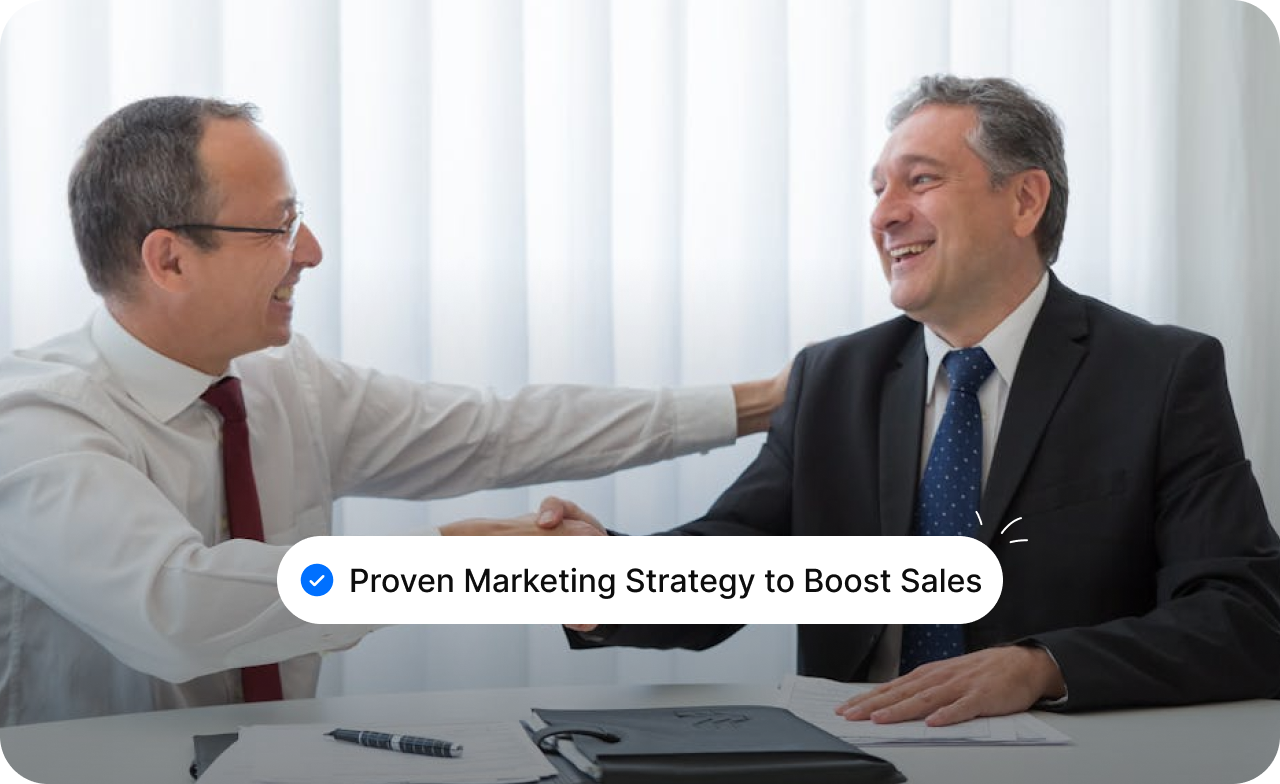
Attracting the right leads is a constant challenge, particularly for manufacturers with complex, high-value products.
Generic content might generate traffic, but it often fails to bring in qualified prospects who understand the true value of what you offer.
Without the right sales tools and resources aligned with your content, your sales team can end up wasting time on leads that don’t convert.
This guide will show you how combining content marketing with sales enablement can help manufacturers attract the right buyers, streamline the sales process, and close deals faster.
Content marketing and sales enablement are two distinct but complementary strategies.
Understanding the difference, and how they can work together, will help you build a more efficient and effective sales process.
Content marketing is the process of creating valuable content to attract, engage, and educate potential customers. It can include blog posts, videos, social media updates, and more.
Sales enablement is about equipping your sales team with the tools, content, and training they need to engage with prospects effectively and close deals faster.
This can include product information, case studies, and sales playbooks.
To further enhance your understanding of sales enablement and its significance in the sales process, watch the following brief video:
[Embed the video here]
This visual guide will provide a quick yet comprehensive overview, helping to solidify the concepts discussed.
Content marketing nurtures leads by educating and informing them, while sales enablement gives your sales team the right tools to convert those educated leads into paying customers. Together, they form a powerful, efficient sales process.
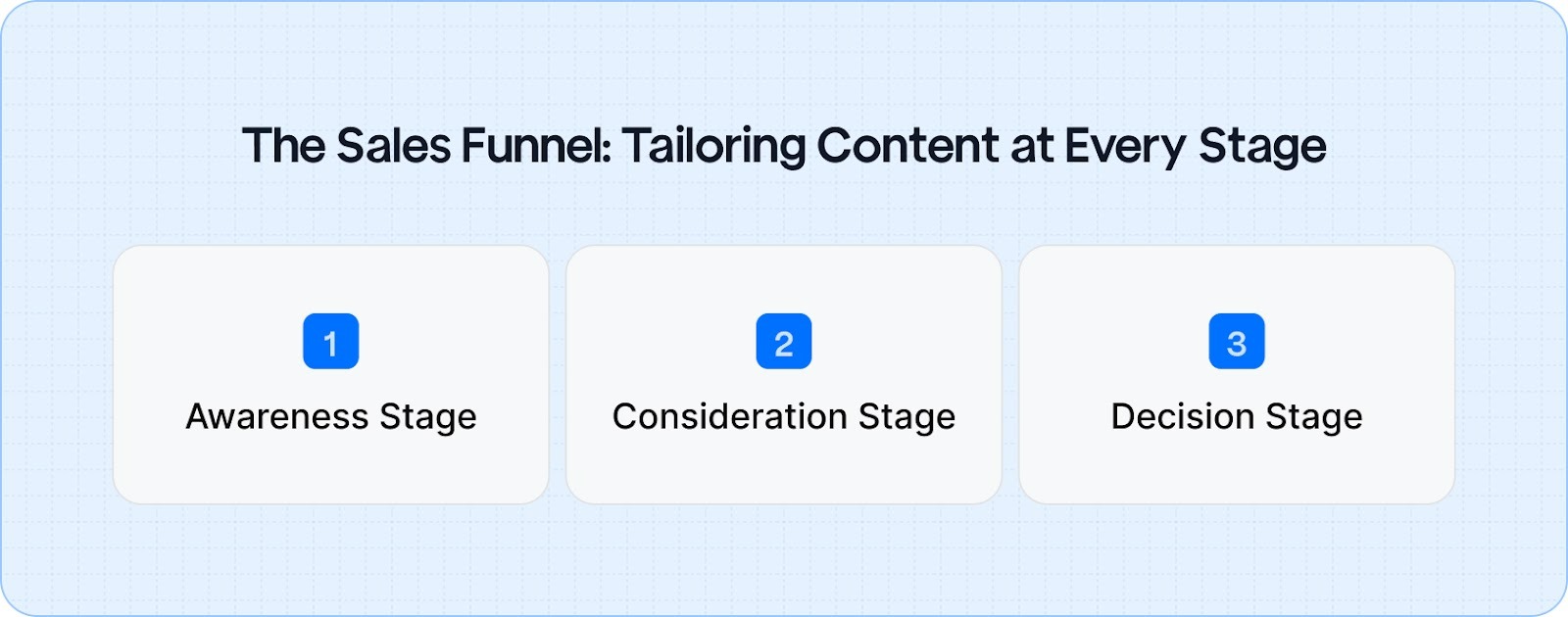
The sales funnel is the process a potential customer follows before making a purchase. It starts with them realizing they have a problem and ends with them deciding to buy a solution.
Each stage of the funnel requires different types of content to guide the customer along the way.
In this stage, prospects are becoming aware of their problem and searching for solutions. Your goal is to educate them about their challenges and introduce your product as a possible solution.
At this point, prospects know their problem and are considering options. You need to show them why your product is the best choice to solve their problem.
Now, prospects are ready to decide. They just need the final pieces of information to make the purchase. This is where your product-specific content comes in.
Your sales team plays a key role in guiding prospects through these stages. Sales enablement content, such as battlecards (quick reference guides), product sheets, and pitch decks, help your team answer questions and provide the right resources at each stage of the buyer's journey.
A Reddit thread from the r/ProductManagement community highlights valuable insights on creating effective sales enablement materials.
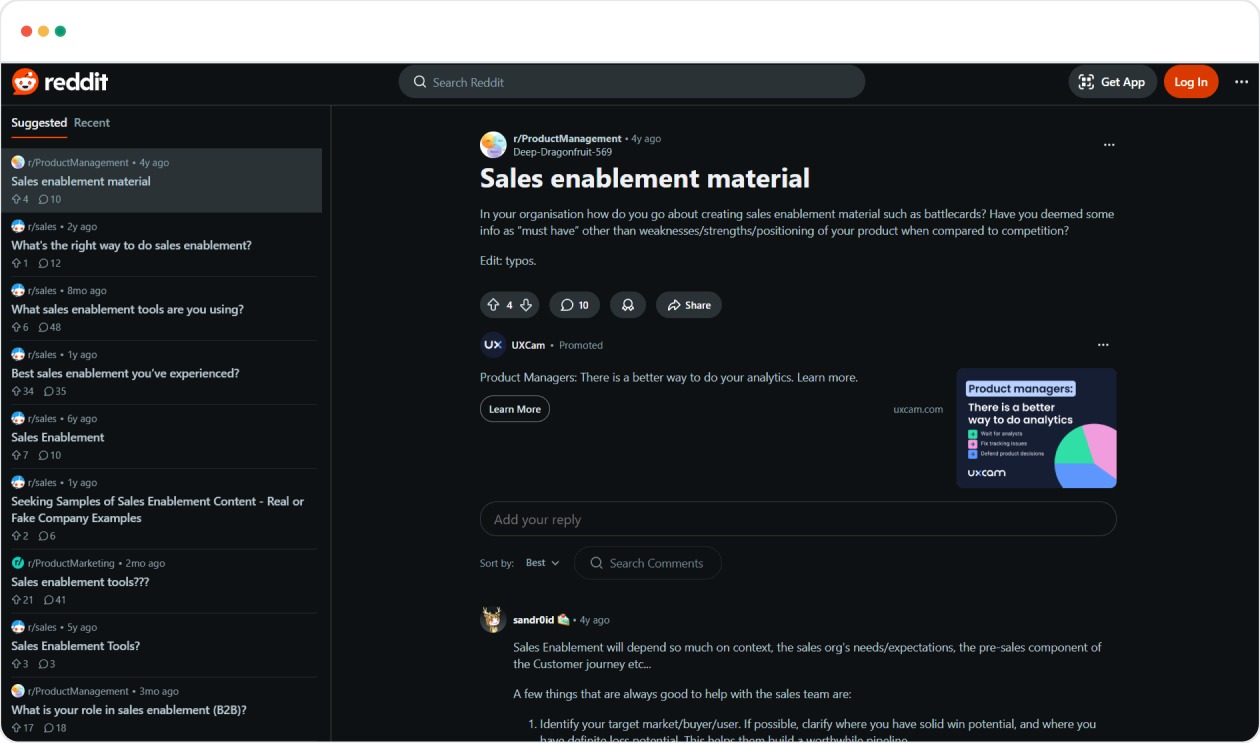
The thread also points to useful tools and strategies, which ensures that sales teams can quickly find the answers they need.
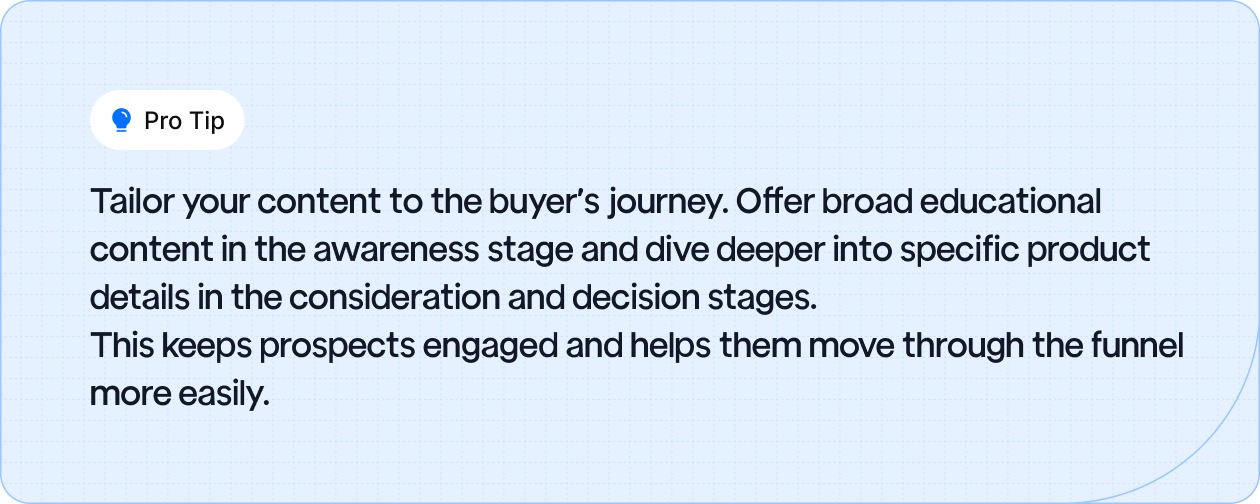
In many businesses, marketing and sales teams work separately, each focusing on their own goals.
But for manufacturers, especially those with complex products, success comes when both teams collaborate closely.
When marketing and sales are aligned, they create a seamless experience for the prospect, guiding them smoothly from the first interaction to the final sale. Without this partnership, leads can get lost, and valuable opportunities are missed.
How they work together:
Marketing’s job is to create content that raises awareness and attracts potential customers. This includes blog posts, social media updates, videos, and more. But attracting leads is just the first step.
Sales teams take over to nurture these leads and move them through the buying process using the content marketing team has provided. Think of marketing as the "first impression," and sales as the "closer."
Example: Marketing creates a blog post explaining the benefits of your product’s energy efficiency, while the sales team uses that content in follow-up emails to further educate leads and answer specific questions.
For content marketing to be truly effective, sales teams need to provide feedback on what content works, and what doesn’t.
If a particular blog or video helped close a deal, marketing needs to know so they can create more content like it. This feedback loop ensures that both teams are continuously improving their strategies.
Example: Sales may tell marketing that prospects love detailed case studies, leading marketing to create more of these success stories to help close deals.
Collaboration tools, like CRM systems and shared content libraries, are vital for aligning marketing and sales. These tools make it easy for both teams to access and share the right content at the right time.
When marketing and sales have access to the same up-to-date resources, they can move leads through the funnel more effectively, ensuring that no valuable information is lost.
Example: Both teams can use a shared library to access product demos, pricing guides, or competitive battlecards, ensuring that sales reps are always using the most relevant and accurate content during conversations with prospects.
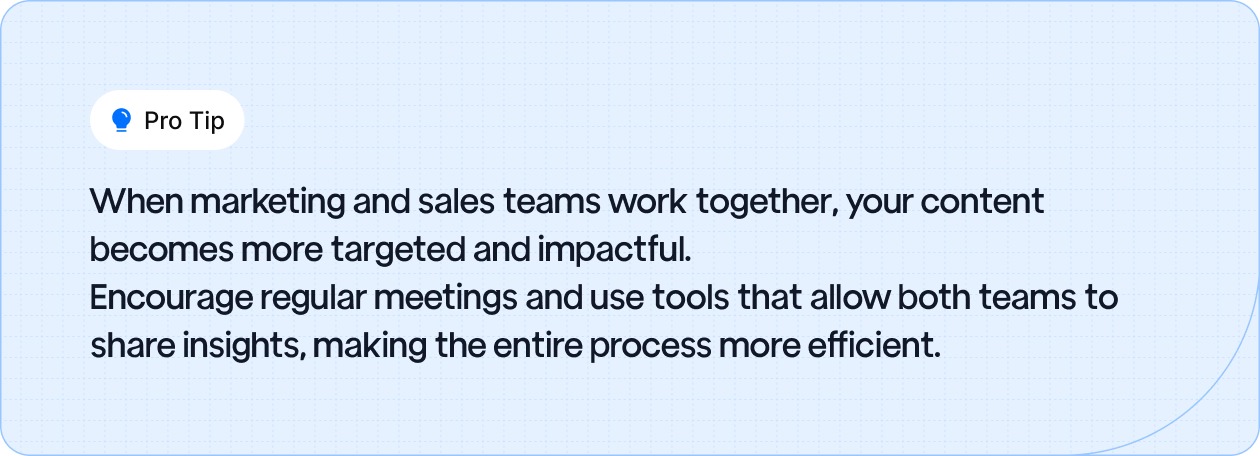
Sales enablement content refers to all the resources your sales team uses to engage with customers effectively and close deals. These materials help salespeople educate, persuade, and move prospects through the buying process.
Examples of sales enablement content include:
Internal sales content helps your sales team become more knowledgeable and efficient in their roles. These resources prepare your team to have confident, consistent conversations with prospects.
External sales content is used by the sales team when interacting with potential customers. This type of content is designed to move prospects closer to making a purchase.
Each type of sales enablement content is designed to address specific buyer needs at different stages of their journey.
When used effectively, these resources help your sales team provide the right information at the right time, making their pitches more effective and increasing the likelihood of closing the sale.
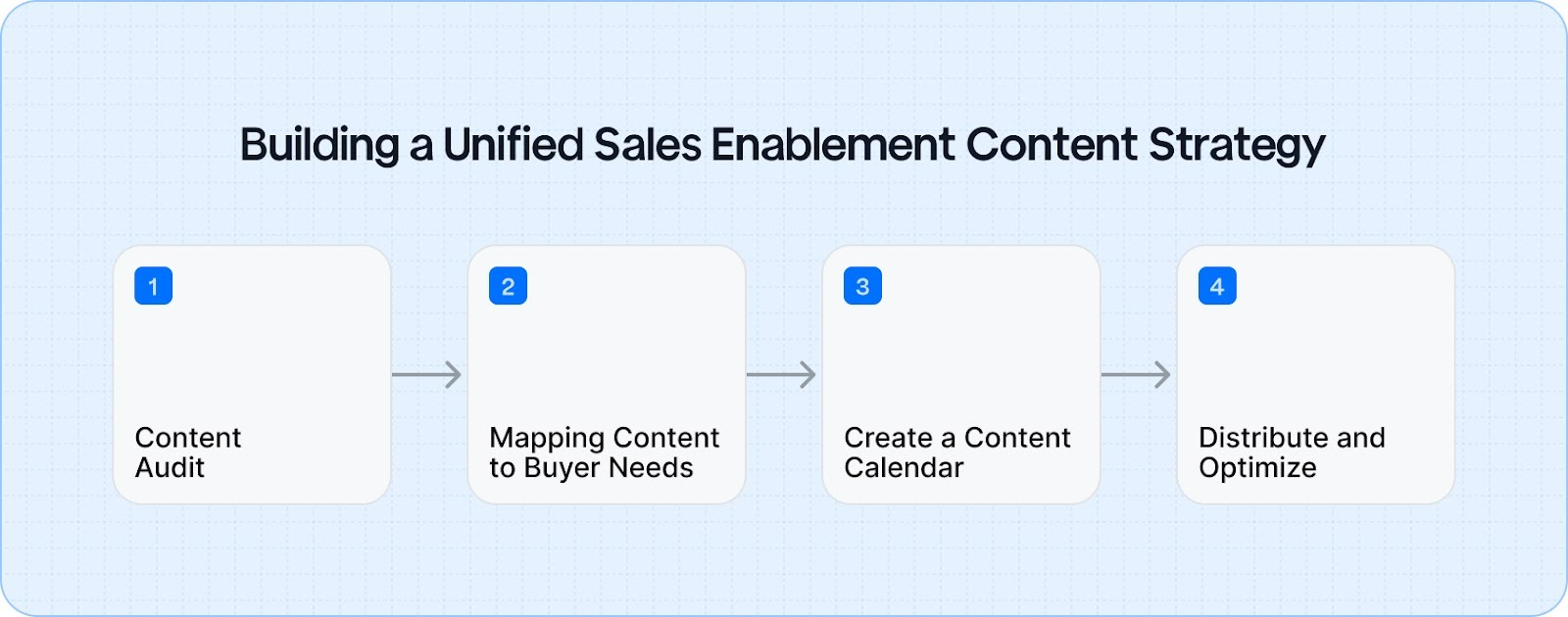
A well-structured content strategy is essential for aligning marketing and sales teams, ensuring that the right content reaches the right prospects at the right time.
Follow these steps to build a unified sales enablement strategy.
Begin by reviewing your existing content. Identify which resources are performing well and which ones are not. This helps in understanding what resonates with your audience and what needs improvement or updating.
Align your content with different buyer personas and sales stages (awareness, consideration, decision). Each type of content should address specific pain points at each stage of the buyer’s journey.
Plan your content creation based on when your prospects are most likely to need it. Align the release of new content with sales campaigns, product launches, or industry events to ensure maximum relevance and impact.
Use content management systems (CMS) to organize and distribute content easily to your sales team. Make sure content is readily accessible and track its usage to see what works best in converting leads.
Easy-to-use tools like HubSpot, Salesforce, and Google Drive help automate and organize your content distribution. These tools allow seamless sharing, content tracking, and performance analysis to optimize content use.
Actionable Tip: Leverage CRM tools to analyze which content drives the highest conversion rates and ensure that your sales team has real-time access to high-impact content.
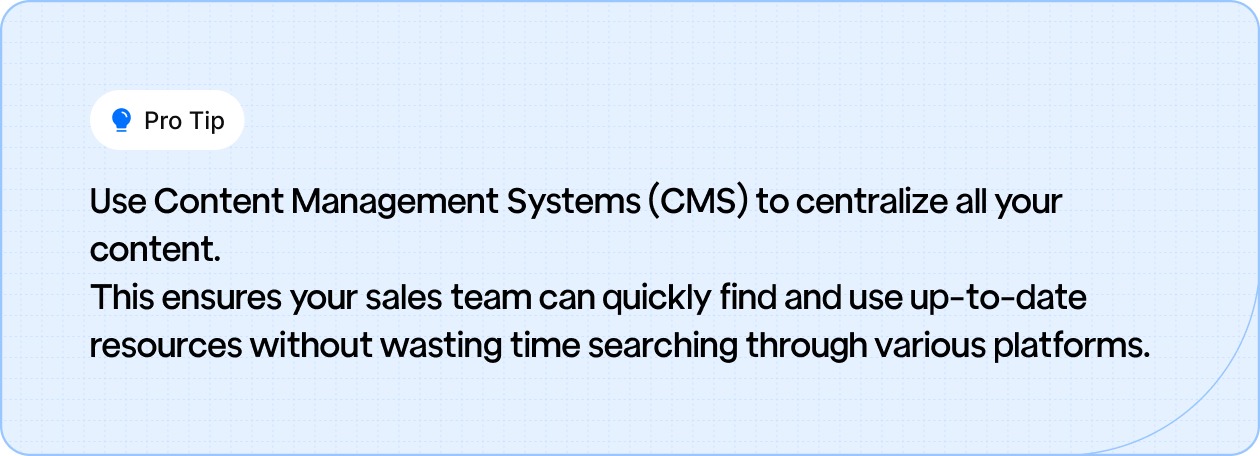
Creating content that drives results for your sales team requires more than just putting together a few materials.
It’s about delivering the right content at the right time and in the right way. Here’s how to optimize your content to make sure it actually supports your sales efforts.
Your content needs to speak directly to the buyer’s pain points at each stage of the buying process.
Rather than offering generic information, make sure the content is specific to the buyer’s challenges and how your product provides a solution.
While personalized content is key, it can be difficult to create for each individual buyer. Fortunately, modern tools allow you to scale this personalization without losing its impact.
By using automation and CRM tools, you can deliver personalized content at every touchpoint, such as email and product demos.
Sales teams often need content at a moment’s notice, during a call with a prospect or while in the middle of a demo.
Ensuring that your sales team has immediate access to the right materials can make all the difference between closing a deal and losing a lead.
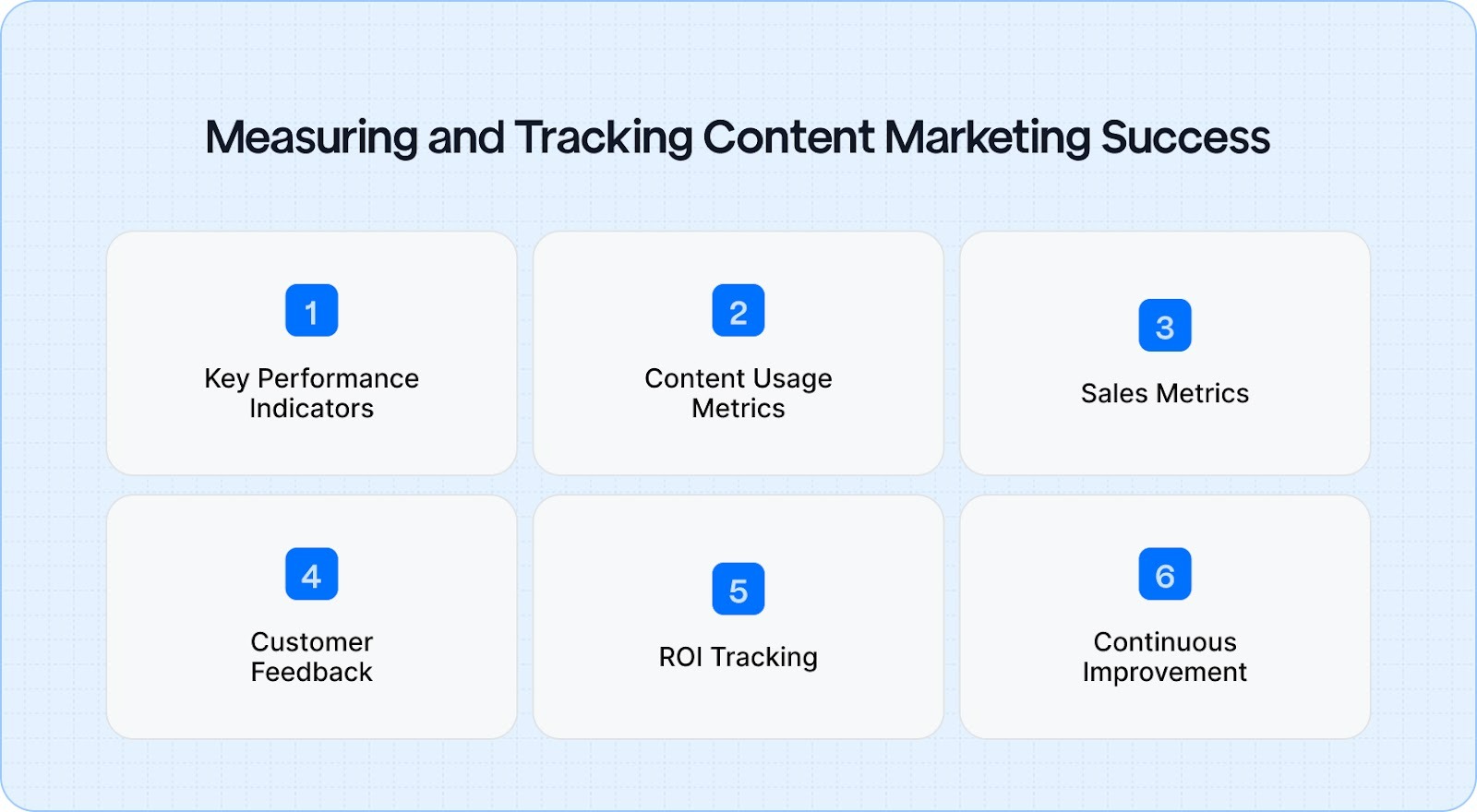
Tracking the success of your content helps refine your strategy. Here’s how to measure if your content is delivering the results you want.
KPIs like lead generation, conversion rates, and engagement help track content success.
Actionable Tip: Focus on metrics like conversion rates and lead quality to assess content effectiveness.
Track how often and which content is used by your sales team. This helps identify what’s working and what needs improvement.
Actionable Tip: Use CMS tracking to see which content gets the most engagement from your team.
Metrics like win rates and conversion rates show how well content helps move prospects to a sale.
Actionable Tip: Compare deals that used specific content versus those that didn’t to see what’s driving success.
Feedback from sales teams and prospects can highlight which content is resonating and what needs refinement.
Actionable Tip: Collect feedback regularly to understand what content works best in different sales situations.
Measuring ROI helps you understand if content is delivering value relative to the investment.
Actionable Tip: Track revenue generated by content-driven leads alongside production costs to gauge ROI.
Adjust your content strategy based on performance data. Regular updates keep your content relevant and effective.
Actionable Tip: Conduct quarterly content reviews to optimize based on data.
Aligning content marketing and sales can be challenging. Here are some common barriers and how to overcome them.
Key Challenges:
Solutions to Overcome These Barriers:
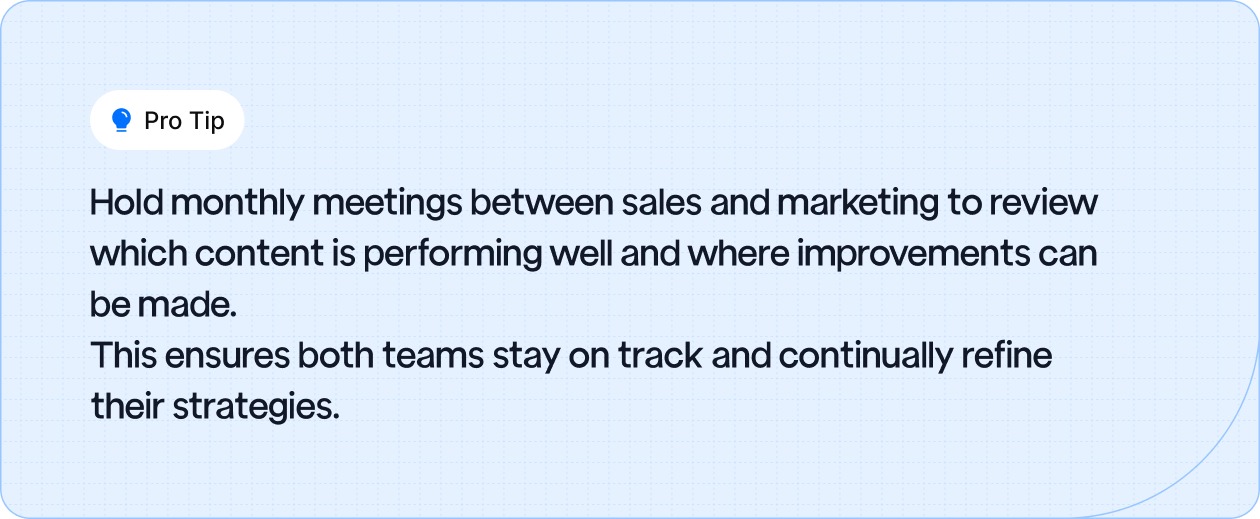
Aligning content marketing with sales enablement is essential for improving sales performance.
When your content is tailored to buyer needs, easily accessible by your sales team, and continuously optimized, you create a smooth sales process that drives results.
Key Takeaways:
Ready to enhance your sales enablement content strategy?
Q1. What’s the difference between content marketing and sales enablement?
A1. Content marketing focuses on creating valuable content to attract and educate potential customers. Sales enablement equips your sales team with the tools and resources they need to engage effectively with these prospects.
Q2. How can content marketing help my sales team?
A2. By providing educational materials like blog posts, videos, and case studies, content marketing helps your sales team engage prospects early in the buyer's journey, building trust and addressing their needs before direct sales efforts begin.
Q3. What types of content should be included in a sales enablement strategy?
A3. Effective sales enablement content includes:
These materials help sales teams address specific buyer needs and make their pitches more effective.
Q4. How do content marketing and sales enablement work together?
A4. Content marketing attracts and educates leads, while sales enablement ensures your sales team has the resources to convert these leads into customers. Together, they create a seamless and efficient sales process.
Q5. What are the key performance indicators (KPIs) for measuring success?
A5. Important KPIs include:
Tracking these metrics helps assess the effectiveness of your content strategy and sales efforts.
Q6. How can I align my sales and marketing teams effectively?
A6. Foster open communication through regular check-ins, invest in shared tools like CRM systems, and implement feedback loops where sales teams provide input on content effectiveness. This alignment ensures both teams work towards common goals.
Q7. What are the common barriers to effective content marketing and sales enablement alignment?
A7. Key challenges include siloed teams and difficulty accessing content. Overcome these by encouraging regular communication between sales and marketing, investing in technology to streamline content access, and implementing systems for continuous feedback.

Selling industrial products is about targeting the right buyers who understand the complexity of your offerings. You manufacture high-end machinery or custom components, and the real pain point is attracting the right leads.
You're selling technical solutions to procurement teams who need precision, quality, and reliability. The problem? Too often, marketing strategies generate volume over quality, leading to wasted ad spend and sales teams bogged down by unqualified leads.

If you’ve ever had to sift through endless inquiries from unqualified buyers, you understand that generic marketing strategies fall short when it comes to promoting industrial products.
This article will show you how to develop a targeted marketing strategy that gets your products in front of the right decision-makers, those who truly understand the value you bring.
Industrial products often require more technical, niche marketing efforts due to their complexity and specialized customer base. It focuses on selling complex, high-value products to businesses that need them for specific functions.

A successful marketing strategy involves precise positioning, understanding your audience, and crafting educational content that resonates with your target buyers. These core elements help build trust and drive qualified leads.
First, you need to position your product clearly. What makes it stand out? What value does it bring? Strong branding ensures your product is memorable and easily recognizable.
Create buyer personas, detailed profiles of your ideal customers. Understanding their needs, challenges, and how they make buying decisions will help you craft tailored marketing messages.
Offer valuable content that helps to solve problems and make informed decisions about your product.
Example:
To further guide you in creating an effective industrial marketing strategy, check out this quick video on the simple steps to develop one.
Digital marketing tools like ABM, AI-powered SEO, and social media are transforming how industrial products are marketed. Leveraging these tools can enhance your outreach and connect you with key decision-makers more efficiently.
ABM is all about targeting specific, high-value accounts. This means focusing your efforts on a smaller set of prospects who are the best fit for your product. You can tailor your marketing specifically for each of these accounts, ensuring a higher chance of conversion.
AI tools are revolutionizing marketing by speeding up tasks like keyword research and content generation. You can create high-quality content faster and improve your SEO to rank higher in search results, bringing more targeted traffic.
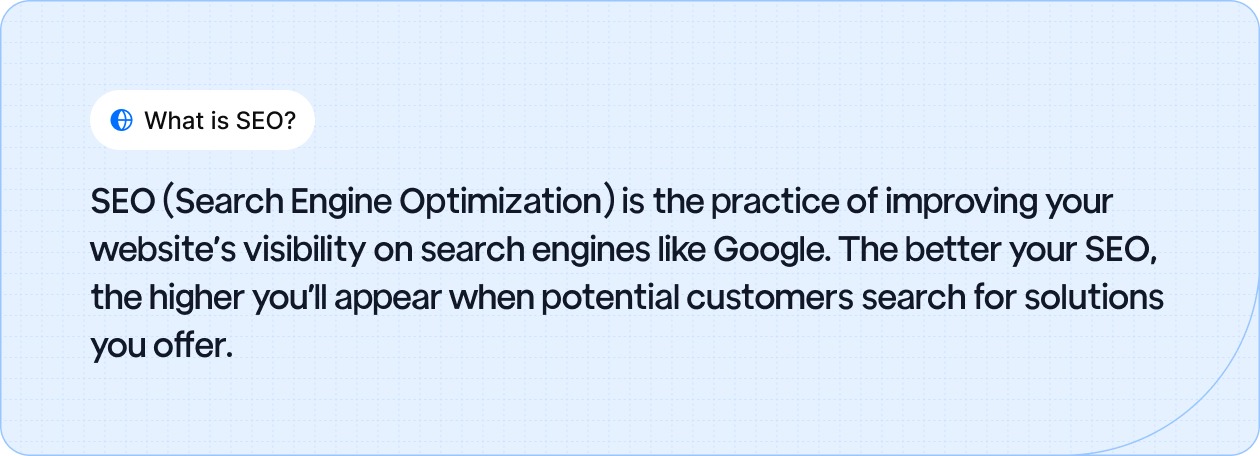
Social media platforms like LinkedIn are powerful for connecting with B2B decision-makers. Sharing content, networking with industry professionals, and using LinkedIn ads can drive meaningful leads for industrial products.
While digital marketing is critical, traditional methods like trade shows and direct mail remain powerful for building relationships and demonstrating products.
Integrating both approaches maximizes your marketing effectiveness.

In-person events like trade shows and industry conferences are making a comeback. These are great opportunities to showcase your products, network with potential clients, and build relationships.
But today, you need to pair them with digital efforts for a comprehensive approach.
Direct mail might seem old-fashioned, but it’s still a powerful tool, especially when combined with digital strategies.
Personalized brochures, product catalogs, and postcards can grab attention and drive action when used correctly.
Industrial product marketing comes with unique challenges, but with the right strategies, you can simplify complex products and manage long sales cycles effectively.
Overcoming these hurdles ensures your efforts resonate with the right audience.
Industrial products often come with technical specs that can overwhelm your audience. The key is to simplify and relate these specs to real-world benefits:
Focus on the customer’s pain points. Explain how your product meets specific needs, saves energy, reduces downtime, and improves safety, without delving too much into technical details.
Long sales cycles are a given in industrial marketing, but keeping prospects engaged is key:
Many in the industry are facing the challenge of reaching the right leads or navigating complex product descriptions.
Check out this Reddit conversation for a broader look at how manufacturers can approach industrial marketing.
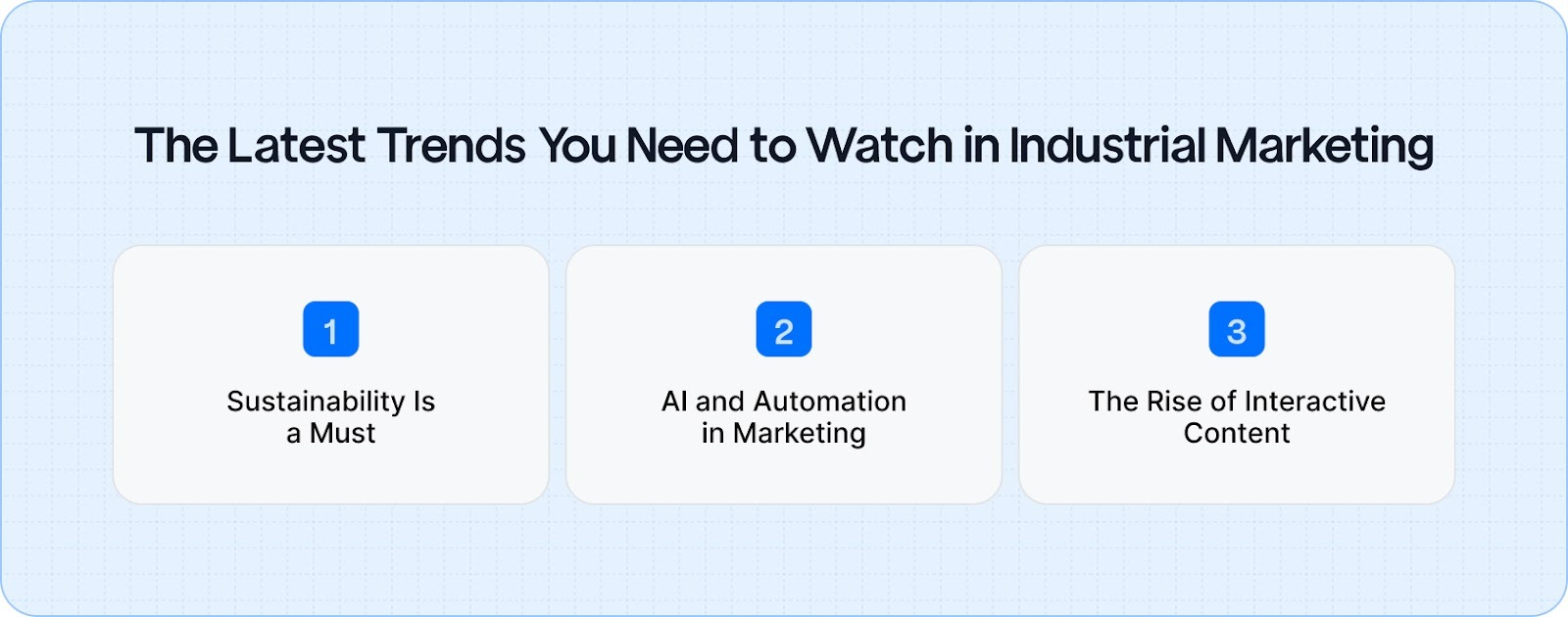
Staying ahead of trends like sustainability, AI, and interactive content can give your marketing efforts an edge. Embracing these trends ensures your brand stays relevant and attracts modern buyers.
Eco-conscious buyers are more prevalent than ever. Showcase how your products contribute to sustainability:
Static content is becoming less effective. Interactive tools engage prospects better:
Measuring success in industrial marketing means tracking the right metrics to optimize your efforts. Here’s how to focus on what truly drives growth and results.
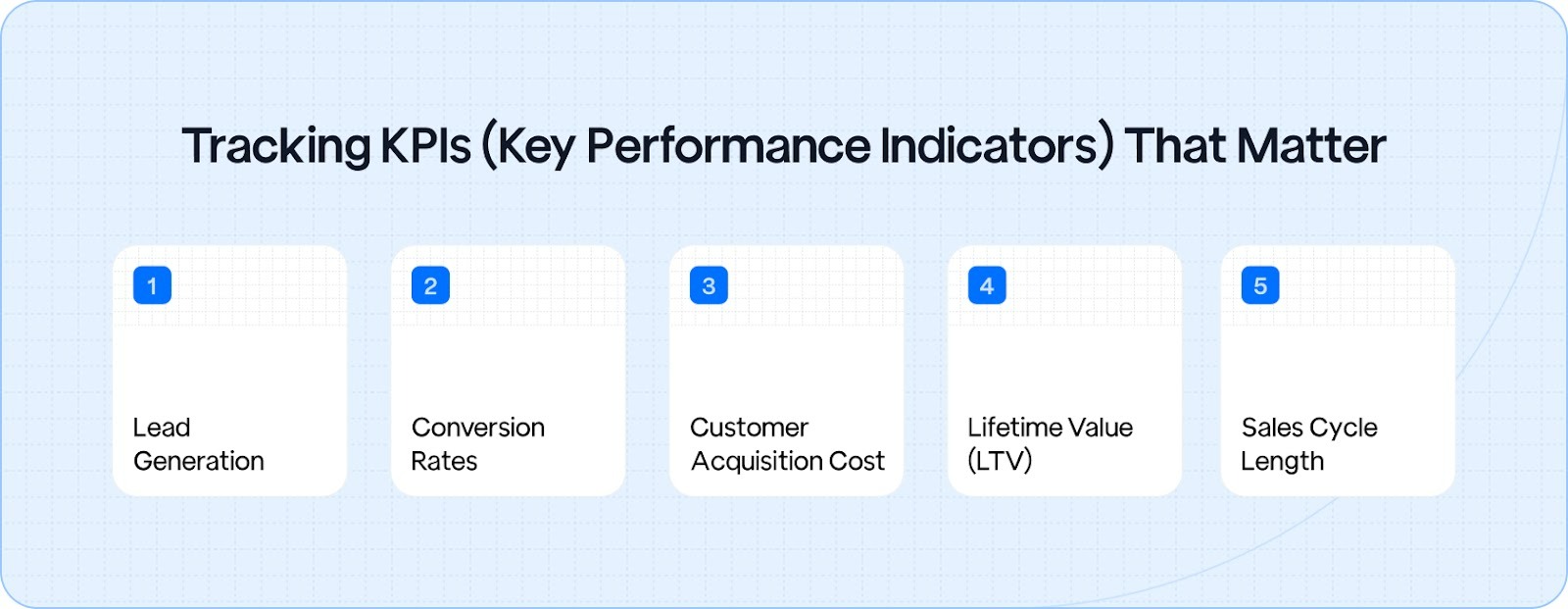
Focus on key metrics that directly impact your marketing and sales:
These KPIs help you assess the effectiveness of your marketing and adjust as needed.
Use these tools to measure your KPIs:
These tools offer valuable insights to optimize your strategy.
A/B testing helps you improve key elements of your marketing:
Industrial marketing demands a targeted approach that combines positioning, account-based marketing (ABM), valuable content, and the right digital tools to drive meaningful results.
If you’re still relying on outdated methods or hoping for a DIY fix, it’s time to shift gears. The real challenge is ensuring you’re reaching the right decision-makers with content that resonates.
A1. An effective industrial marketing strategy includes:
A2. Industrial marketing is more specialized, focusing on:
A3. Content marketing in the industrial sector serves to:
A4. Manufacturers can enhance their SEO efforts by:
A5. ABM allows industrial companies to:
A6. Sustainability is increasingly vital, as it:
A7. Key performance indicators (KPIs) include:

Buyers today are more informed, comparison-driven, and focused on reliability; they look for brands that demonstrate expertise and trust before making a purchase.
Many businesses invest in SEO but fail to attract qualified leads because their strategies don’t reflect how technical buyers actually search.
Effective HVAC SEO connects your brand with people actively seeking your systems and solutions, turning visibility into measurable growth.
HVAC SEO (Search Engine Optimization) is the process of improving your website so potential customers can easily find your HVAC solutions online.
For manufacturers, this means ranking for specific terms related to HVAC systems, components, and services while targeting industries and regions that matter most to your business.
When done right, SEO transforms your website into a 24/7 lead-generation channel that reaches decision-makers at every stage of their buying journey.
If your products or services are difficult to find online, you are missing direct opportunities to convert high-intent buyers.
An optimized website attracts visitors, builds credibility and trust, helping your brand become the go-to choice for HVAC solutions in your target markets.
Consistent visibility reinforces authority, improves brand recall, and keeps your business ahead of competitors bidding for the same customers.
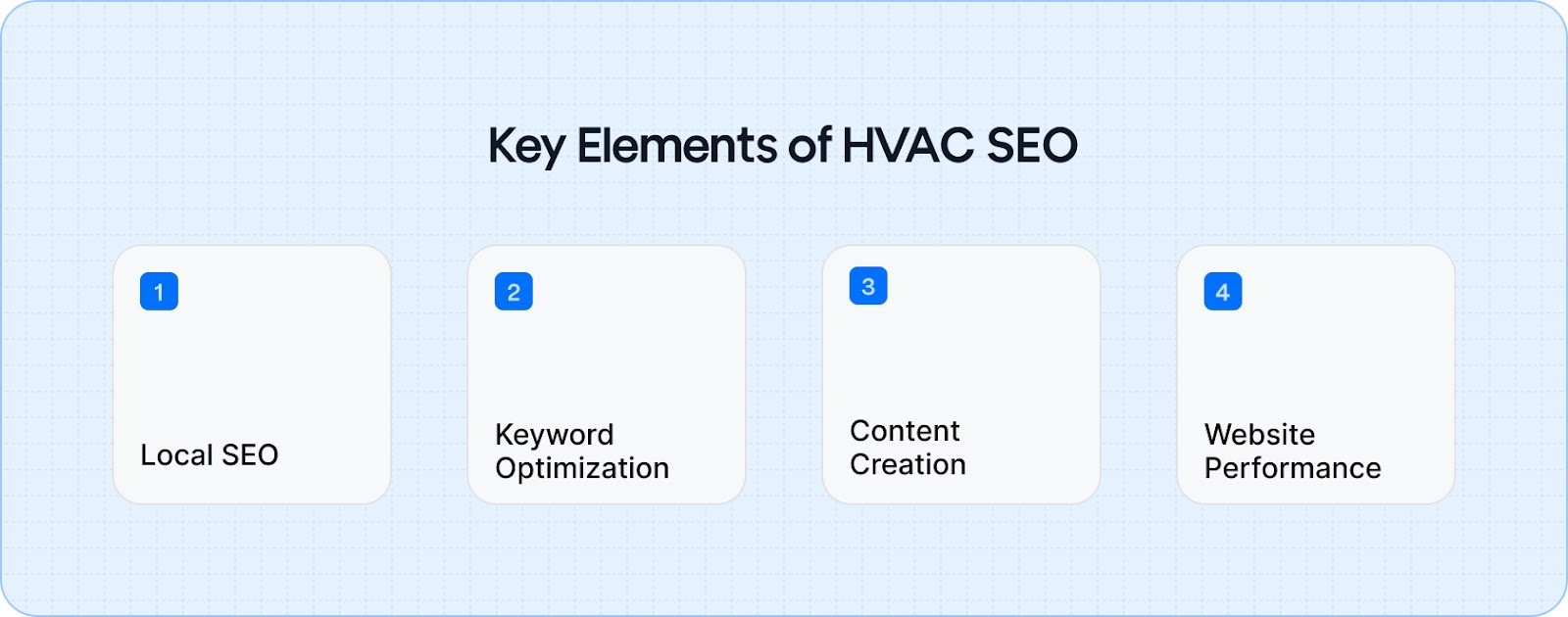
Local SEO: Appear in location-based searches like “HVAC manufacturers near me” to connect with distributors, contractors, and businesses in your service areas.
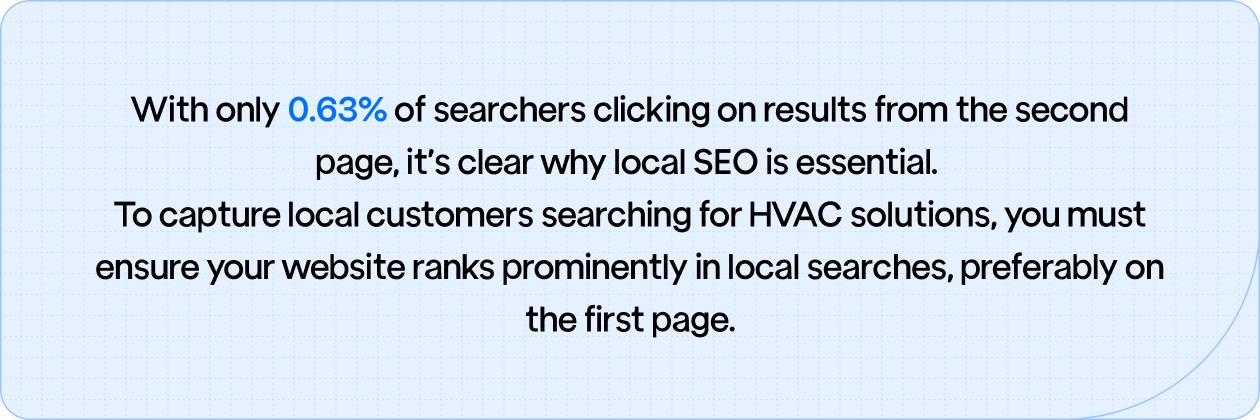
Boosting your HVAC business’s online visibility starts with the right SEO strategies. Here are 15 proven tips that can help you drive local traffic and generate more qualified leads.
Your Google Business Profile acts as your digital storefront for local customers.
Local directories such as Yelp, Angi, and the Better Business Bureau help you build local trust signals.
Target keywords specific to your service areas, like “AC repair in [City]” or “furnace installation near me.”
For every location you serve, create a page optimized for that specific area.
Use keyword tools like SEMrush or Google Keyword Planner to discover what your target audience is searching for.
Long-tail phrases attract buyers who are closer to making a purchase.
Build trust by educating your audience instead of selling to them.
Videos allow buyers to see your products in action, a powerful differentiator for manufacturers.
A slow website signals poor performance to both users and Google.
Fast-loading websites reflect professionalism and keep potential customers engaged.
With more searches happening on mobile devices, ensure your site is mobile-friendly.
Your metadata determines whether someone clicks your link or scrolls past.
Social platforms amplify your visibility and drive referral traffic.
Reviews strengthen both trust and search rankings.
Partnerships and collaborations can power your SEO.
Regularly monitor your website’s traffic, keyword rankings, and conversions using tools like Google Analytics.
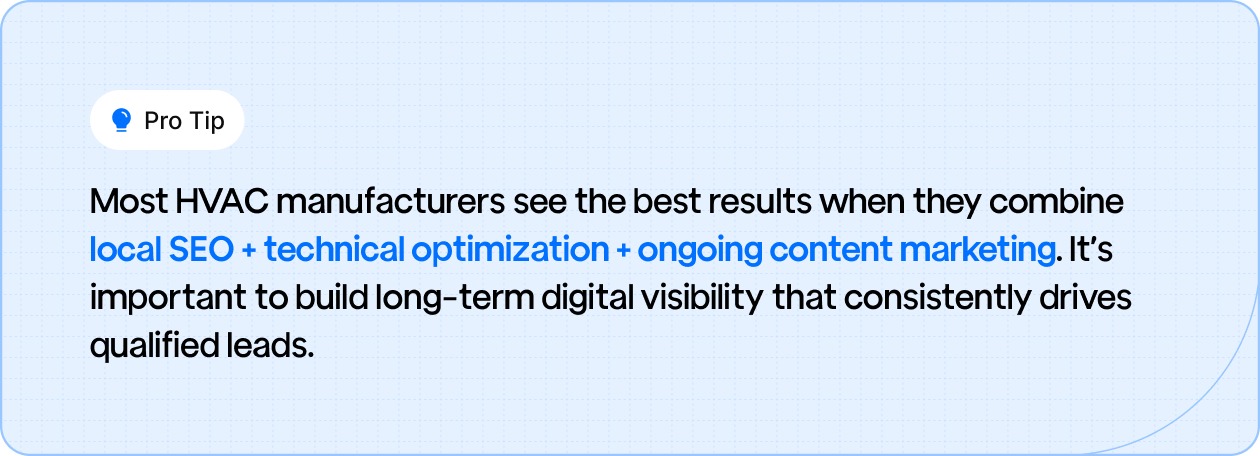
Tracking and measuring your HVAC SEO efforts is crucial for understanding what’s working and what needs improvement.
Here’s how you can effectively track your SEO success and optimize your strategy.
Use analytics tools to identify which HVAC product or service pages drive the highest conversion rates.
Look for traffic sources, such as organic search vs referral, to understand where your most qualified leads originate. For example, if your “commercial HVAC units” page receives steady traffic but low inquiries, the content may need better CTAs or technical specifications.
Track your presence across different regions or distributor zones using tools like BrightLocal or GeoRanker.
For HVAC manufacturers, visibility in multiple territories matters; evaluate rankings for city clusters where you want to expand (e.g., Chicago, Milwaukee corridor) rather than a single city.
Track which product pages or keywords drive inquiries from your ideal customers (e.g., OEMs, contractors, or procurement teams).
Use CRM integrations or call-tracking tools to connect digital leads with actual orders, helping quantify SEO’s ROI.
A Reddit user shared their experience of investing $20,000 in SEO services, only to achieve a return of $6,800 over four months. They expressed frustration with the lack of results and considered taking a course to manage SEO independently
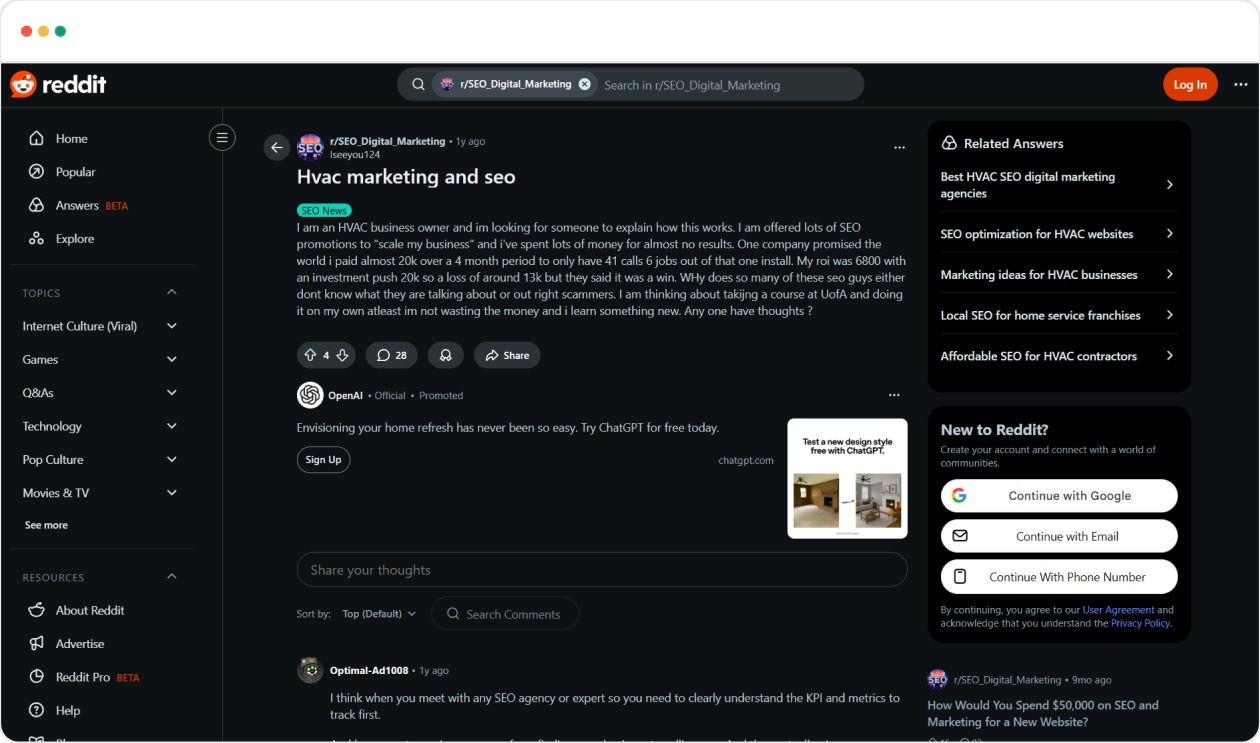
This highlights the importance of selecting an SEO partner who understands the HVAC industry's unique needs and can deliver measurable results.
To drive sustainable growth for your HVAC business, implementing effective SEO strategies is crucial. By optimizing for local search and targeting industry-specific keywords, you can reach decision-makers like contractors and facility managers actively seeking your services.
Enhancing website speed, mobile responsiveness, and user experience not only improves rankings but also increases customer engagement.
These efforts translate into higher-quality leads, better conversion rates, and strengthened brand authority, giving you a competitive edge in a crowded market.
A1. HVAC SEO (Search Engine Optimization) involves optimizing your website to rank higher in search engine results, making it easier for potential customers to find your HVAC products and services.
For manufacturers, effective SEO increases online visibility, attracts qualified leads, and drives long-term growth.
A2. To enhance local SEO:
A3. Focus on long-tail, location-specific keywords such as “affordable HVAC installation in [City]” or “emergency furnace repair near me”. Tools like Google Keyword Planner and SEMrush can help identify high-intent keywords relevant to your services.
A4. Utilize tools like Google Analytics and Google Search Console to monitor:
Regular analysis helps refine strategies and improve ROI.
A5. If you have the resources and expertise, managing SEO in-house can be effective. However, partnering with an experienced HVAC SEO agency can provide specialized knowledge, save time, and potentially yield faster results.
A6. SEO is a long-term strategy. Typically, it takes 3 to 6 months to see significant improvements in search rankings and lead generation. Consistent effort and optimization are key to sustained success.
A7. Avoid:

Plumbing businesses often face the challenge of standing out in a competitive market. Despite providing excellent services, many plumbers struggle to maintain a consistent flow of work.
Marketing can feel frustrating, with strategies that consume resources without delivering results. Dealing with fluctuating demand and competing with local businesses, it’s clear that marketing needs to create a reliable stream of qualified leads.
This guide will show you how to develop a plumbing marketing strategy that generates consistent leads, builds trust in your brand, and supports long-term growth without wasting time or money.
Your website is the first impression potential clients will have of your business. If it’s hard to navigate or lacks key information, visitors will quickly leave.
A professional, user-friendly website builds trust, increases conversions, and makes it easy for customers to take action.
Actionable Steps:

When customers need plumbing services, they search online, and they’re most likely searching for someone nearby. Local SEO ensures that your business appears in relevant searches, putting you in front of customers actively looking for your expertise.
Actionable Steps:
If you need immediate visibility, PPC (Pay-Per-Click) advertising is one of the fastest ways to get noticed.
These ads allow you to reach customers actively searching for plumbing services, driving high-quality traffic to your website quickly.
Actionable Steps:

Email marketing is an effective tool to maintain relationships with past customers and stay top-of-mind.
Timely, personalized communication helps retain clients and encourages repeat business.
Actionable Steps:
Social media is an essential marketing tool to build brand recognition, trust, and engagement.
It allows you to showcase your expertise and connect with potential customers where they spend their time.
Actionable Steps:

Referral marketing considers the trust that satisfied customers have in your services to bring in new, high-quality leads.
Actionable Steps:

Online reviews are a critical factor in customer decision-making. Positive reviews build credibility, improve local SEO, and influence future clients’ choices.

Actionable Steps:
Providing valuable, educational content positions your business as a trusted authority in your field. It helps build customer confidence and drives organic traffic to your website.
Actionable Steps:

Local business partnerships can help you tap into new customer bases and create mutually beneficial relationships. Partnering with complementary services increases your brand visibility and opens doors to referral business.
Actionable Steps:

Marketing is an ongoing process of trial and error. To achieve consistent growth, you must track, analyze, and optimize your campaigns to improve your return on investment.
Actionable Steps:
Effective plumbing marketing requires a strategic approach to attract consistent, qualified leads. From building a user-friendly website to optimizing for local SEO and using paid ads, each element plays a crucial role in creating a reliable pipeline of customers.
Without a targeted marketing strategy, businesses often waste time and resources on efforts that don’t drive meaningful results.
The core challenge is developing a marketing system that delivers predictable and high-quality leads. If current efforts aren’t yielding the desired growth, it’s time to implement a more refined strategy.
A1. Focus on building a professional website optimized for search engines (SEO) and mobile devices. Utilize local SEO strategies to ensure your business appears in local search results. Engage in content marketing by sharing informative blogs or videos that showcase your expertise.
A2. Yes, social media platforms like Facebook and Instagram can help build brand awareness and engage with your community. Sharing behind-the-scenes content, job site updates, and customer success stories can humanize your brand and attract potential clients.
A3. Implementing Pay-Per-Click (PPC) advertising, such as Google Ads, can drive targeted traffic to your website. Additionally, optimizing your Google Business Profile and encouraging satisfied customers to leave positive reviews can enhance your online presence and attract quality leads.
A4. Positive customer reviews build trust and credibility, influencing potential clients' decisions. Actively request reviews from satisfied customers and display them prominently on your website and social media platforms to enhance your reputation.
A5. Yes, email marketing allows you to nurture relationships with existing clients by sending timely service reminders, maintenance tips, and special offers. Segmenting your email list based on past services can personalize your communication and improve engagement.
A6. Utilize tools like Google Analytics and social media insights to monitor engagement and conversion rates. Adjust your campaigns based on performance metrics and set specific goals to measure success and return on investment (ROI).
A7. Building a strong brand identity, optimizing your website for SEO, and incorporating local listings are cost-effective strategies. Additionally, creating valuable content that addresses common plumbing issues can position you as an expert in your field and attract organic traffic.

You can be the best plumber in town, but without the right marketing, it’s easy to get overlooked amidst all the other options out there.
Many plumbers find themselves stuck, struggling to get a steady stream of work, no matter how skilled they are. Marketing without proper understanding makes you spend time and money on strategies that don’t deliver.
And with demand shifting up and down, and the constant pressure of competing with other local businesses, it’s clear that a more reliable system is needed.
This guide will help you understand how to build a plumbing marketing plan that attracts consistent, qualified leads and establishes trust in your brand. All while ensuring long-term growth, without wasting your valuable time or money.
Think of Search Engine Optimization as the process of improving your digital storefront. It helps your products show up in search results when people search for things like plumbing fittings, pipes, or any other relevant terms..
Now, here’s where it gets really important for you: Local SEO. Since most of your customers are in specific areas, local SEO is what makes sure people searching for plumbing supplies in your city can actually find you. It helps to:
By focusing on local SEO, you’re ensuring your plumbing products get in front of the right people at just the right time. It’s an easy way to get more visibility and more sales.
Implementing the right SEO strategies will help you connect with more qualified leads, improve visibility, and drive business growth, especially in your local market.
Get Found Locally with Google Business Profile Optimization
You know how important it is for your plumbing products to be visible when local contractors or homeowners search for them.
By optimizing your Google Business Profile and making sure your business shows up on Google Maps, you’ll gain a serious competitive edge.

Here's how to make sure your local presence is strong:
Location-Specific Keywords
Make sure you’re using the right local search terms that match how people in your area actually search for plumbing services. For example, instead of broad keywords, use targeted ones such as “emergency plumber in [City]”, “pipe repair near [Location]”, or “water heater installation in [Region]”.
To make this strategy work, you should:
This approach ensures your plumbing business appears in search results when nearby homeowners or businesses look for your specific services.
Targeting Local Plumbing Keywords on Key Pages
When it comes to your website, make sure you're using local keywords on the important pages, like your homepage, product pages, and blogs. For example, include terms like “plumbing fittings in [City]” or “water heater parts near [Region]” in your content. This makes it easier for local customers to find you.
Optimizing for Mobile and User Experience
More people are searching on their phones than ever before, so if your website isn’t mobile-friendly or doesn’t load quickly, you’re losing valuable traffic.
Use tools like Google PageSpeed Insights to ensure your site is fast and responsive.
Blogging for Plumbing Businesses: Answering the Tough Plumbing Questions
One of the best ways to attract visitors is by creating helpful content.
Use keywords that reflect how your local customers actually search for plumbing services. For example, focus on phrases like “plumber near [City]”, “24-hour plumbing service in [Area]”, or “bathroom pipe repair [Region]”.
To make the most of these keywords:
This approach helps your plumbing business rank higher for searches that directly convert—people actively looking for a plumber in your area.
Using Educational Video Content to Engage Visitors
Videos are a great way to keep customers engaged. Think about creating product tutorials, installation guides, or even a factory tour video.
Embedding these on your product pages can lower your bounce rate and improve your SEO rankings.
Optimizing Your Site Structure
Make sure your website is easy to navigate, with clear categories for your products.
A simple, organized structure makes it easier for users to find what they need, and helps search engines crawl your site more efficiently.
Implementing structured data (Schema Markup) can help search engines better understand your plumbing website’s content, allowing key details like service type, ratings, pricing, and operating hours to appear directly in search results.
This makes your service pages stand out and improves visibility in local searches and boosts click-through rates.
Building High-Quality Backlinks
Getting backlinks from plumbing associations, contractors, and other industry websites is crucial. Backlinks from reputable sites like plumbing suppliers or home improvement blogs can increase your authority and boost your SEO.
Creating Shareable Content for Link Building
Write content that others want to share. This could be articles, infographics, or case studies about plumbing trends or common issues. The more shareable your content, the more backlinks you’ll earn.
In a Reddit Thread, a small plumbing company owner shares their journey into SEO, highlighting challenges like acquiring quality backlinks and the impact of local SEO on rankings.
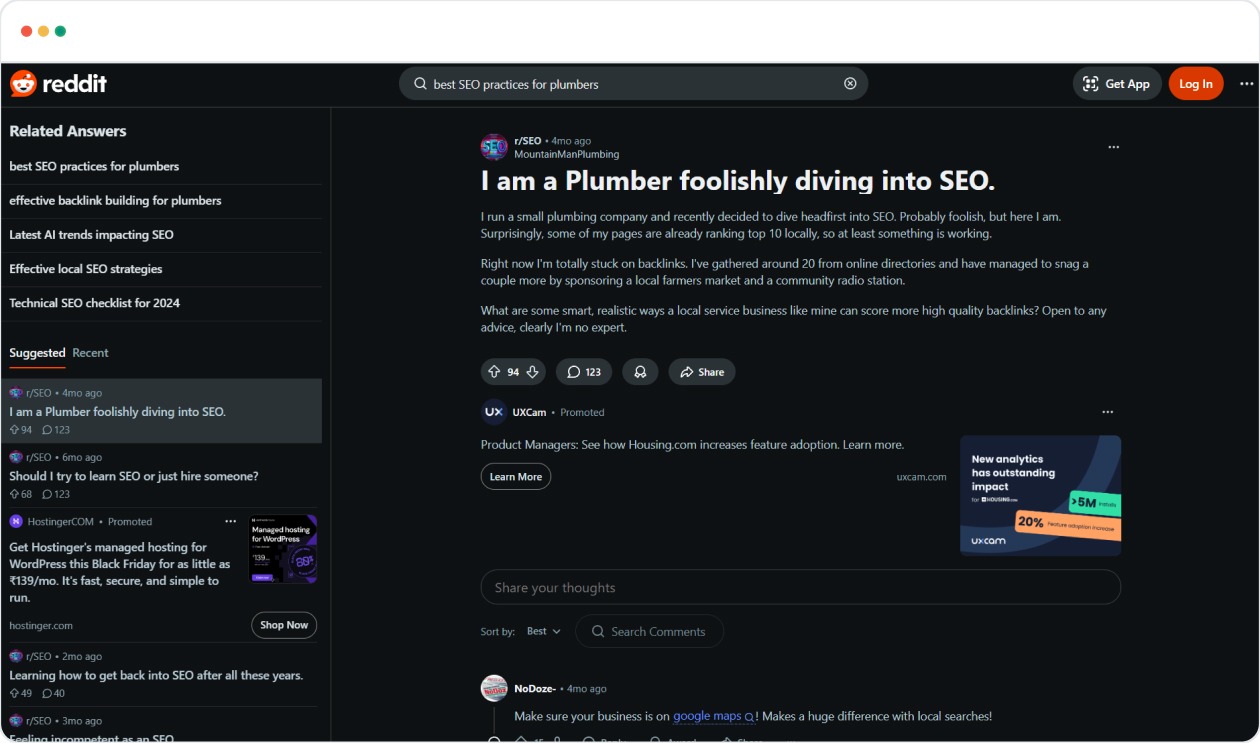
Gushwork specializes in addressing these issues by implementing AI-assisted SEO strategies tailored for local service businesses. Our approach has helped clients achieve significant improvements in search engine rankings and online visibility.
Using Google Analytics & Google Search Console
To see how your SEO efforts are paying off, use Google Analytics and Google Search Console to track important metrics like organic traffic growth, keyword rankings, and conversion rates.
Setting up custom goals allows you to measure how many leads or orders you're getting through organic search.
It’s extremely important for businesses to continuously optimize their SEO strategies.
Here’s how you can keep your SEO efforts relevant, effective, and aligned with the latest trends:
Search engines like Google frequently update their algorithms, which can impact your website's ranking. To stay ahead of these changes:
SEO isn’t a one-time task; it requires ongoing attention. Conduct SEO audits every 3 to 6 months to assess your site’s performance and identify areas for improvement:
Outdated content can harm your SEO rankings. Keep your website fresh and relevant by:
SEO trends are always evolving. Some important areas to focus on:
While it cannot directly isolate voice-search traffic, you can use it to identify rising interest in conversational, question-based queries (which often correspond to voice searches), giving you indirect insight into voice-search trends.
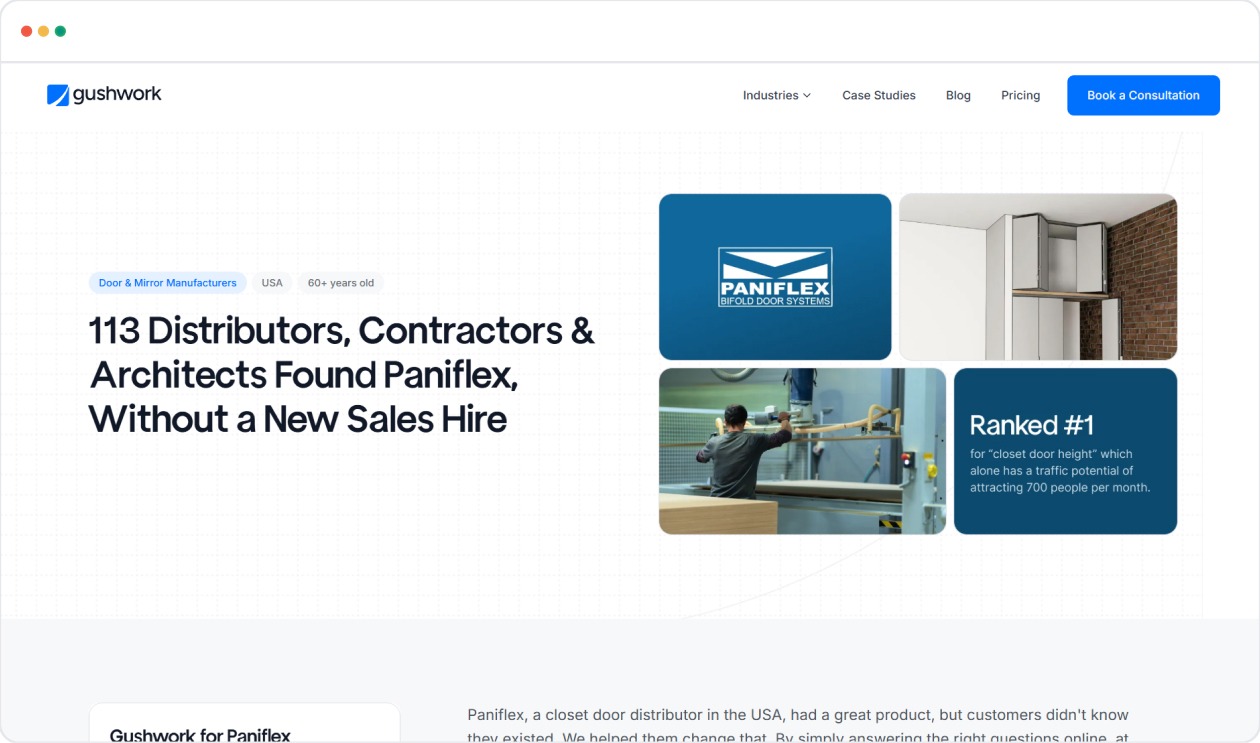
Paniflex, a closet door distributor in the USA, had a great product but faced a critical challenge: their potential customers couldn’t find them.
Despite their quality offerings, they were invisible online, missing out on significant business opportunities.
Gushwork stepped in to help them shift their SEO strategy. We focused on providing the right information at the right time, helping Paniflex answer technical questions that potential buyers were searching for.
This approach included creating valuable resources like product specifications, installation guides, and technical details that architects, contractors, and designers needed for their projects.
The results were remarkable:
This strategy didn’t just bring more traffic; it changed the way Paniflex did business. Sales calls became more productive, as customers were already knowledgeable about the products.
Additionally, Paniflex's competitors struggled to match the technical depth and expertise that Paniflex offered, allowing them to charge more for their products and solidify their position as a trusted expert.
This case study demonstrates how a well-executed SEO strategy can generate high-quality leads without the need for additional sales hires, providing a sustainable long-term advantage.
As you now know that simply relying on basic SEO tactics will not help. To truly dominate local searches and drive qualified leads, you need a strategic, long-term approach.
By optimizing for local SEO, refreshing your content, and focusing on technical SEO, you can ensure your business shows up when it matters most.
A1. Focusing on SEO is crucial for plumbing. Optimizing your Google Business Profile (GBP) is a key strategy. Ensure your business name, address, and phone number (NAP) are consistent across all online platforms.
Encourage satisfied customers to leave positive reviews, as this can significantly boost your local search rankings. Additionally, creating location-specific content and obtaining backlinks from local businesses can further enhance your SEO efforts.
A2. Effective SEO strategies for plumbing include:
A3. To attract more qualified leads, plumbing businesses should:
A4. Reviews play a significant role in local SEO. Positive reviews on platforms like Google My Business can improve your business's visibility in local search results. They also build trust with potential customers, influencing their decision-making process.
Encouraging satisfied clients to leave reviews and responding to them promptly can enhance your online reputation and SEO performance.
A5. Building backlinks involves acquiring links from other reputable websites to your own. For plumbing companies, effective strategies include:
A6. Common SEO mistakes to avoid include:
A7. SEO is a long-term strategy, and results can vary based on factors such as competition and the effectiveness of your efforts. Generally, it can take 3 to 6 months to start seeing noticeable improvements in rankings and traffic. Consistency in implementing SEO best practices and patience are key to achieving sustainable results.

For manufacturers, sales teams often spend more time on administrative tasks, like data entry and follow-ups, than engaging with high-value prospects.

This leaves little time for focusing on what matters: building relationships and closing deals. Sales enablement automation can eliminate these manual tasks, allowing your team to focus on driving results.
This guide will explore 10 strategies to help streamline your sales process, enhance team efficiency, and close more deals.
In manufacturing sales, the sheer volume of administrative tasks, like inputting data, scheduling meetings, and sending follow-up emails, can weigh down sales teams.
These tasks are time-consuming and often distract from core activities such as nurturing leads and closing deals.
Sales enablement automation removes these blockages by handling the repetitive work, so your team can focus on high-impact sales activities.
Also Read: Sales Enablement for Manufacturing: 5 No-Nonsense Ideas
Personalized outreach is essential for engaging prospects, but crafting individual emails and nurture sequences can be time-consuming, especially with large prospect lists.
Sales enablement automation helps streamline this by tailoring content and follow-ups based on individual lead behavior and engagement.

Sales teams often struggle to find the right content when they need it, wasting valuable time.
By centralizing and automating content delivery, sales enablement tools give reps instant access to the latest resources and product info, boosting efficiency and consistency.
In a relevant Reddit thread, a sales professional shared their frustration with a disorganized content management system: "We spent hours hunting for case studies, pricing sheets, and materials across Google Docs and emails.
It was like playing a treasure hunt, but with no treasure at the end. It wasn’t just a time waster; it hurt our chances with prospects because we couldn't get the right resources in front of them quickly.”
This is a common challenge, and Gushwork addresses this directly by centralizing your content, streamlining access, and ensuring your team always has the most relevant, up-to-date materials at their fingertips. This simple shift allows reps to focus on what matters, connecting with leads and closing deals faster.
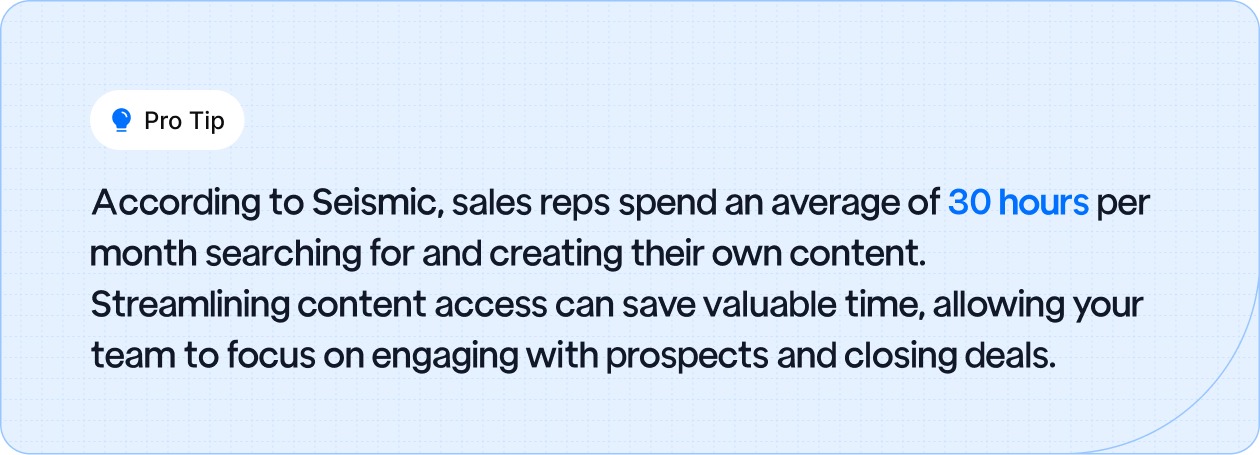
Tracking and scoring leads manually is labor-intensive and results in missed opportunities. Sales enablement automation can take the guesswork out of lead prioritization, scoring and ranking leads based on engagement and behavior.

Coaching is crucial to driving sales performance, but it can be time-consuming to track each rep's progress manually. AI-powered sales enablement tools provide real-time feedback and performance metrics, allowing managers to deliver tailored coaching without the manual effort.
Pro Tip: AI-powered coaching can reduce ramp-up time by 30%, improving overall team performance and ensuring faster development of new reps.
For manufacturers, creating accurate proposals and quotes can be a lengthy process, often slowing down the sales cycle.
Sales enablement automation can generate accurate, branded proposals and quotes in real-time, ensuring that pricing and terms are correct and saving valuable time for your sales reps.

Accurate sales forecasting is crucial for manufacturers to plan inventory, production, and resource allocation.
Sales enablement tools that leverage AI can analyze historical data and lead behavior, providing more accurate sales forecasts and predicting deal closures, giving you a clearer picture of future revenue.
Pro Tip: AI-powered forecasting improves sales prediction accuracy by 20%, giving manufacturers better insights to make smarter business decisions.
Manufacturers often face challenges in keeping up with post-sale follow-ups and ongoing customer engagement.
Automating these processes ensures that customers receive timely support, reducing churn and increasing retention rates.

Silos between sales and marketing can result in missed opportunities and inconsistent messaging.
Sales enablement automation helps align both teams by centralizing data, content, and goals, ensuring they work together to drive results.
Must Read: Mastering B2B Sales Enablement: Strategies, Tools, and Best Practices

To ensure your sales enablement automation is effective, it’s essential to measure performance.
Tracking metrics like sales cycle time, win rates, and content usage gives your team insights into what’s working and what needs improvement.

Sales enablement automation is a necessity for manufacturers aiming to streamline their sales processes and boost revenue.
By reducing manual tasks, enhancing forecasting accuracy, and improving overall team performance, automation allows your sales team to focus on what truly matters: closing deals.
The challenge of juggling time-consuming tasks is real, and relying on outdated methods is no longer enough for modern success. It’s time to transform your sales process with tools that will elevate your performance.
Q1. What is sales enablement automation, and how can it benefit my manufacturing sales team?
A1. Sales enablement automation streamlines sales processes by automating tasks like lead scoring, content delivery, and follow-ups. For manufacturers, this means less time spent on administrative duties and more focus on building customer relationships and closing deals.
Q2. How does automating lead scoring improve sales outcomes in manufacturing?
A2. Automated lead scoring uses data-driven insights to prioritize leads based on their likelihood to convert. This ensures your sales team focuses on high-potential prospects, leading to higher conversion rates and more efficient use of resources. Platforms like Gushwork integrate with your CRM to automate this process seamlessly.
Q3. Can sales enablement automation tools integrate with our existing CRM system?
A3. Yes, many sales enablement automation tools are designed to integrate with popular CRM systems like Salesforce and HubSpot. This integration ensures a seamless flow of information, allowing your sales team to access real-time data and insights without switching between platforms.
Q4. What role does content management play in sales enablement automation?
A4. Effective content management ensures that your sales team has access to the right materials at the right time. Automated content delivery systems can recommend and provide up-to-date resources, reducing the time spent searching for information and improving the quality of customer interactions.
Q5. How can sales enablement automation assist in training and onboarding new sales reps?
A5. Automation can streamline the onboarding process by providing new hires with structured training modules, resources, and assessments. This ensures consistency in training and reduces the time it takes for new reps to become productive.
Q6. What metrics should we track to measure the success of sales enablement automation?
A6. Key metrics include lead conversion rates, sales cycle length, content usage rates, and rep productivity. By analyzing these metrics, you can assess the effectiveness of your automation efforts and make data-driven decisions to optimize your sales processes.
Q7. Is sales enablement automation suitable for small to mid-sized manufacturing businesses?
A7. Absolutely. Sales enablement automation tools are scalable and can be tailored to fit the needs of small to mid-sized businesses. By automating repetitive tasks, these tools free up your sales team's time, allowing them to focus on strategic activities that drive growth. Gushwork offers solutions designed to meet the needs of businesses of all sizes.

Engaging with decision-makers who possess a deep understanding of the technical complexities of your products is essential.

You're offering custom machinery, specialized materials, or high-end industrial solutions, and the real issue is attracting the right leads.
Wasting marketing resources on prospects who don’t understand the precision or value of what you offer only leads to frustration. It’s about connecting with the engineers, procurement teams, and executives who can truly appreciate the intricacies of your product.
This guide dives into the exact strategies that will help you cut through the noise and reach the audience that matters most, ensuring your efforts drive meaningful results.
These five strategies focus on maximizing your marketing impact by utilizing data, personalization, and optimization tools.
Each strategy is designed to cut through the noise, delivering valuable results for industrial businesses.
ABM is a highly focused strategy where you direct your marketing efforts toward a select group of high-value accounts, ensuring every touchpoint is meaningful and personalized.
This strategy eliminates waste, maximizing return by targeting accounts that matter most to your business.
How to Implement:
Must Read: Account Based Marketing for Manufacturers: Reach The Right Buyers
AI tools provide a more effective way to optimize your SEO strategy, automate content creation, and analyze search trends.
These technologies allow you to align your content with buyer intent and optimize it for long-tail and voice search queries, increasing your content’s reach and relevance.
Practical Application:

Educational content is vital in establishing your brand as an industry authority. By addressing your target audience’s pain points and challenges, you build trust and offer real solutions that lead to stronger, long-term customer relationships.
Types of Content:
Also Read: 25+ Proven Strategies to Transform Your Industrial Content Marketing

Using analytics enables you to track the effectiveness of your campaigns, understand buyer behavior, and make informed adjustments to your marketing efforts. This allows you to focus on strategies that drive real results and optimize your marketing ROI.
Tools:

Personalized email marketing is crucial for maintaining engagement and nurturing leads. By targeting buyer personas with tailored messaging, you can increase relevance and build stronger relationships, ultimately improving conversion rates.
Effective Techniques
Alongside core strategies, supporting tactics such as optimizing your website for lead generation, leveraging social media for relationship building, and using paid search ads can amplify the effectiveness of your overall marketing campaigns.
Let’s explore these additional tactics.
Must Read: The B2B Manufacturing Marketing System: Build Visibility, Trust, and Sales
While industrial marketing has its unique challenges, addressing these issues head-on with the right strategies can significantly enhance your marketing effectiveness.
Let’s explore some common pain points and how to overcome them.
To overcome long sales cycles, invest in lead nurturing. Use automated email sequences, content downloads, and webinars to keep leads engaged over time, guiding them through the decision-making process.
A Reddit user recently pointed out a common issue for B2B marketers: “Long lead times, misalignment between sales and marketing, and CRM inefficiencies.” This reflects the struggles many face, miscommunication and delayed decision-making can hinder success.
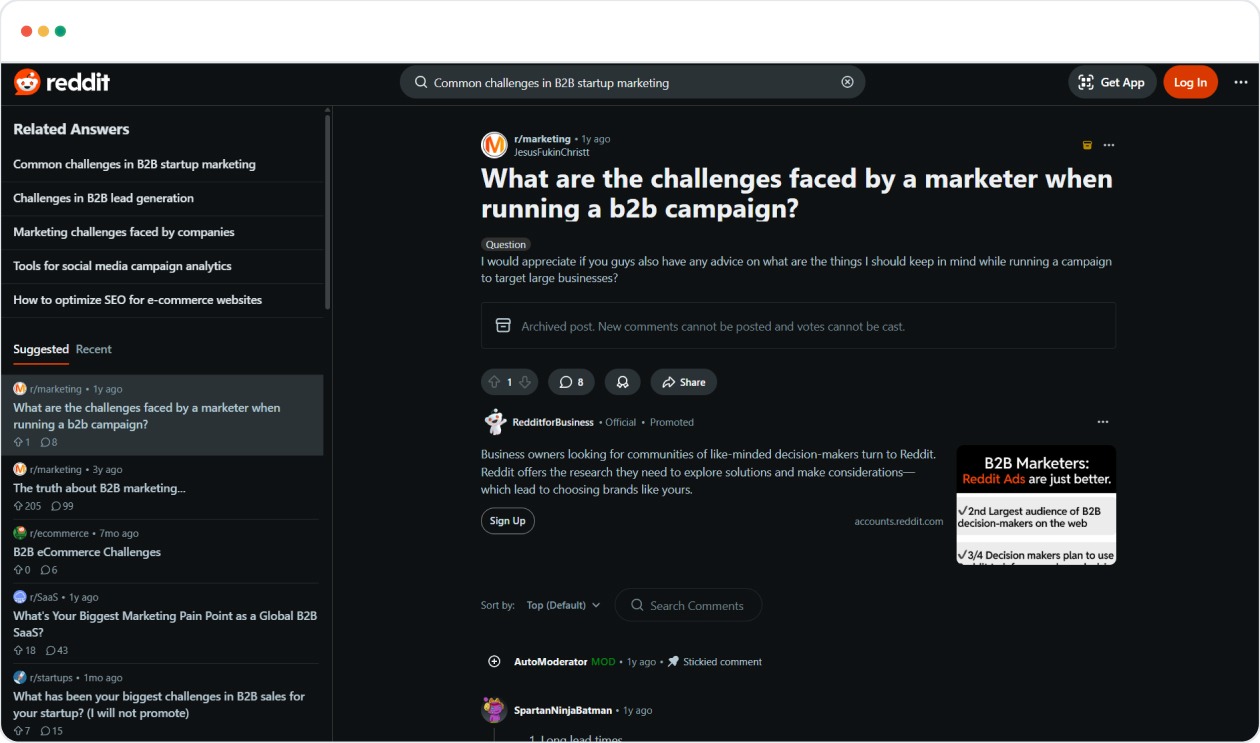
Gushwork streamlines your marketing efforts by automating lead tracking, content personalization, and analytics. It bridges the gap between sales and marketing, ensuring both teams align, shorten lead cycles, and boost conversions.
ABM is your best option here. By targeting key decision-makers with highly personalized content, you can address the unique needs of each person involved in the buying process.

Use a hybrid marketing approach that combines traditional methods like trade shows and direct sales with modern tactics like SEO, PPC, and email marketing. This ensures that your strategy covers all touchpoints with your audience.

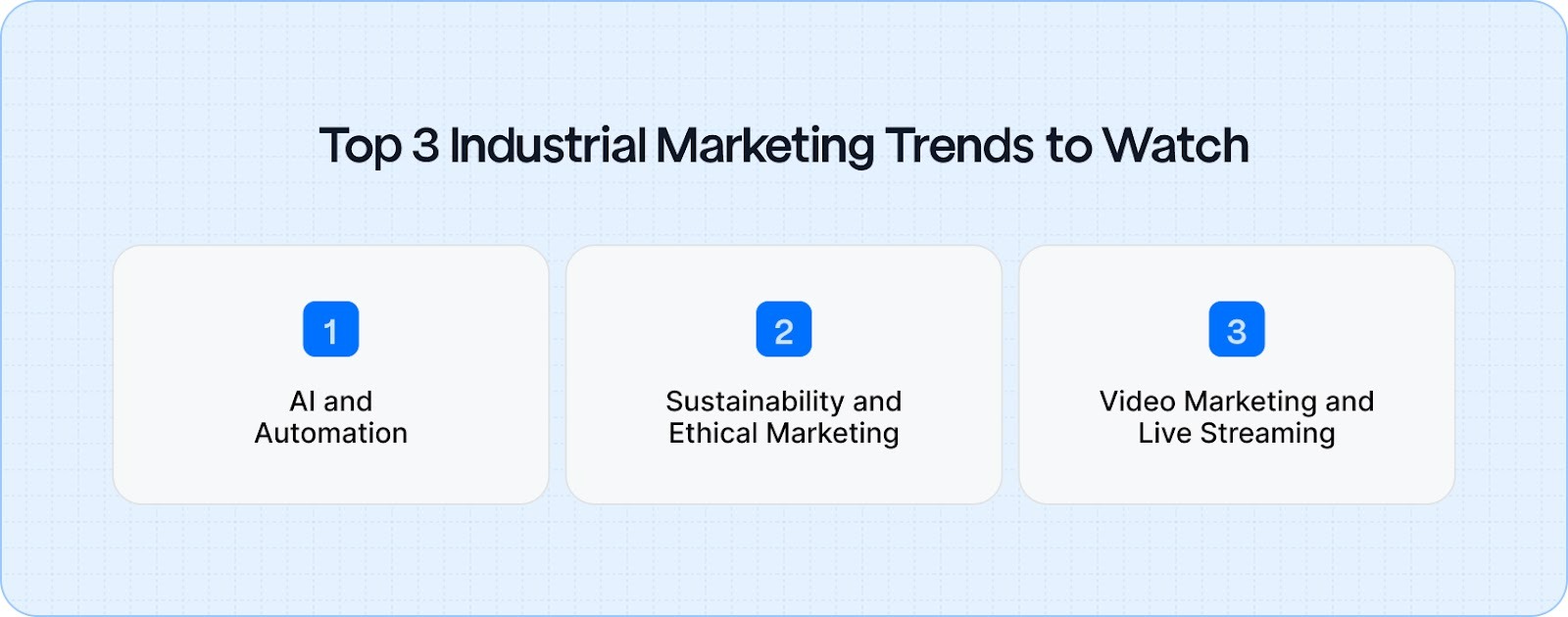
Staying on top of the latest trends is essential to keep your industrial marketing strategy ahead of the curve. Here are the key trends shaping the industrial marketing landscape in 2025.
AI and automation tools are transforming how industrial companies manage content creation, data analysis, and lead nurturing. These technologies streamline marketing processes, allowing for more efficient and personalized outreach.
Future Trends: AI-driven personalization will dominate, providing buyers with hyper-targeted content and recommendations based on their individual behaviors and preferences.
Industrial buyers are increasingly prioritizing sustainability. Brands that demonstrate eco-friendly practices contribute to a greener planet and build trust with their environmentally-conscious audience.
To succeed in industrial marketing in 2025, a reactive approach won’t cut it anymore. It's essential to adopt a holistic strategy that incorporates Account-Based Marketing (ABM), AI-powered tools, and personalized content.
These tactics increase your efficiency and ensure you remain relevant in a highly competitive market.
Ready to elevate your industrial marketing strategy?
Q1. What are the key strategies for industrial marketing in manufacturing?
A1. Effective strategies include Account-Based Marketing (ABM), AI-powered SEO, content marketing, data analytics, and personalized email campaigns to target the right decision-makers in the manufacturing sector.
Q2. How can I implement ABM in industrial marketing?
A2. ABM focuses on high-value accounts by using CRM tools to identify key prospects. Tailor outreach with personalized content, emails, and landing pages, while tracking engagement to refine strategies.
Q3. Why is AI important in industrial marketing?
A3. AI enhances SEO, automates content creation, and optimizes marketing strategies by aligning content with buyer intent. It also allows for continuous content updates and performance monitoring to stay competitive.
Q4. What role does content marketing play in industrial marketing?
A4. Content marketing builds authority by addressing audience pain points through educational content like whitepapers, case studies, and webinars. Repurposing long-form content for social media and emails increases reach.
Q5. How do I track the effectiveness of my industrial marketing campaigns?
A5. Use analytics tools like Google Analytics, SEMRush, and HubSpot to track buyer behavior, measure traffic, and adjust campaigns based on insights to optimize marketing ROI and engagement.
Q6. What is personalized marketing, and how can it improve industrial lead generation?
A6. Personalized marketing uses dynamic content in email campaigns to target specific buyer personas, improving relevance and increasing conversion rates by nurturing leads with tailored messaging.
Q7. What challenges should I expect in industrial marketing, and how can I overcome them?
A7. Common challenges include long sales cycles, complex buyer personas, and integrating traditional marketing with digital tactics. Overcome them with ABM, lead nurturing, and a hybrid strategy of digital and in-person methods.
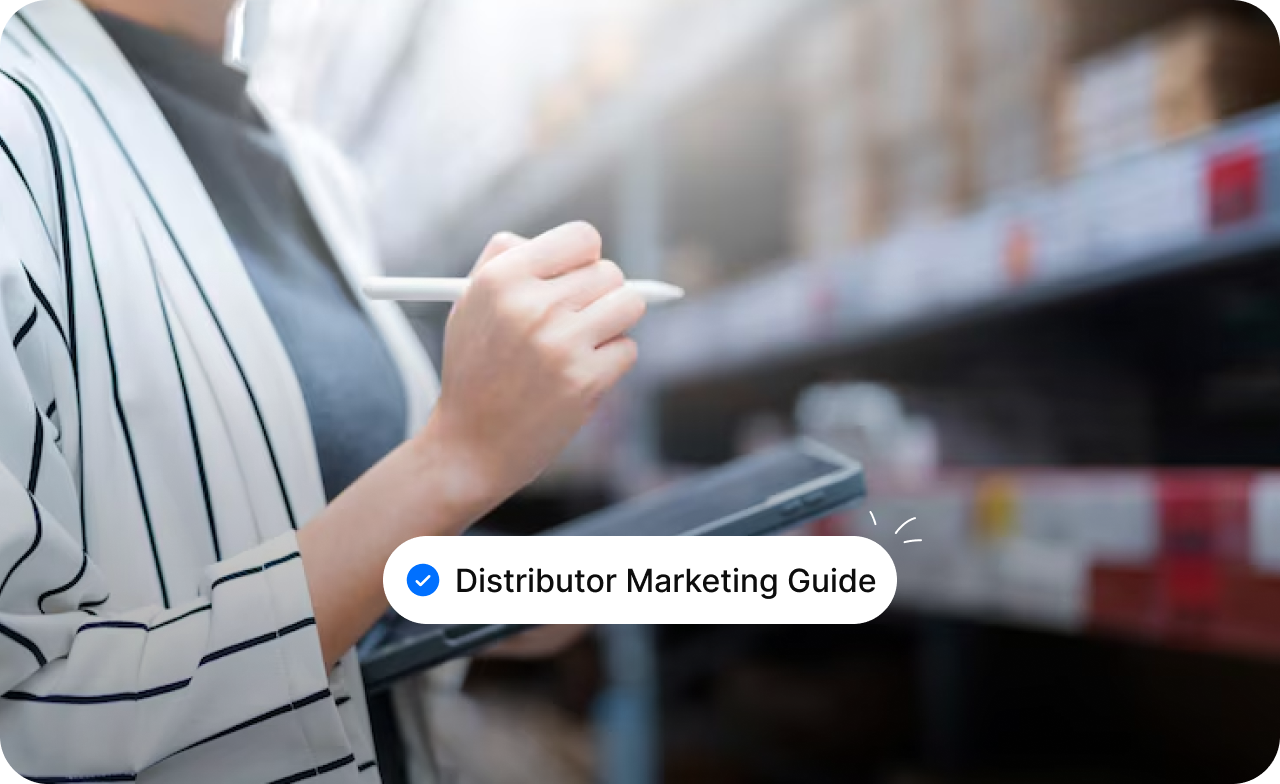
Distributors face the challenge of building relationships with manufacturers while keeping customers satisfied and loyal.

The real struggle is balancing both sides, where one misstep can lead to lost opportunities. In a crowded market with competing distributors offering similar products, simply pushing more sales won’t cut it.
You need a distributor marketing strategy that drives the right leads and builds long-term partnerships.
This article is for you if you're ready to move beyond generic approaches and implement actionable strategies to stand out in a digital-first world.
Distributor marketing is about building long-lasting relationships with manufacturers and customers. Understanding the unique dynamics of the distribution space is crucial to creating a strong foundation that supports long-term growth and success.
Distributor marketing differs significantly from B2C or manufacturer marketing because it involves acting as the bridge between the producer and the retailer.
It requires balancing the needs of both sides while optimizing the flow of products.
Effective distributor marketing is essential to maintaining a cohesive supply chain and seizing growth opportunities. Without it, relationships can weaken, and long-term success may be jeopardized.
Also Read: Why Smart Distributors Are Choosing CRM?
Distributor marketing success hinges on a well-thought-out strategy. Creating a solid marketing plan and using digital tools for increased reach will help you stay ahead in a competitive landscape.
A strategic marketing plan focuses on clear segmentation, goals, and KPIs. This allows you to measure success and adapt your tactics as necessary.
Want to know how to effectively approach distributors? Here’s what some Reddit users suggest on: Best strategies for reaching out to distributors to become a vendor
Incorporating SEO, content marketing, and targeted ads can dramatically increase the reach of your products and services, helping you connect with more retailers and end customers.
Digital catalogs and automated ordering systems streamline the customer journey, making it easier for customers to browse products, check availability, and place orders.
A successful distributor marketing strategy is built on strong, trusting relationships with manufacturers, retailers, and customers. These relationships can be nurtured with the right CRM tools and customer incentives.
CRM tools help distributors build lasting relationships by tracking interactions and personalizing communication. This fosters trust and loyalty, which are essential for long-term success.
Must Read: Best CRM for Manufacturing Companies: 5 Platforms That Track Leads Better
Referral programs incentivize customers to bring in new clients, while loyalty programs keep existing customers engaged, fostering a cycle of growth.
Building trust and aligning goals with vendors is crucial for distributors. It enables better marketing efforts and helps them stay competitive in the market.
Managing vendor relationships effectively requires open communication and strategic alignment. Distributors must balance supplier and customer needs to maintain productive partnerships.
With the rise of e-commerce and D2C models, distributors need to differentiate themselves in a crowded space. Focusing on service quality and customer satisfaction is key to staying competitive.
Distributor marketing comes with its own set of challenges. Staying competitive amidst market disruption and using data for smarter decisions are crucial hurdles to overcome for sustained growth.
E-commerce and D2C models are putting pressure on distributors. By offering value-added services and strengthening relationships, distributors can weather these disruptions.
Using customer data and analytics helps distributors refine their strategies, improve marketing ROI, and make informed decisions based on real-time insights.
Emerging technologies, such as AI and automation, are revolutionizing distributor marketing. Embracing these technologies will help distributors streamline operations and gain a competitive advantage.
The future of distributor marketing lies in embracing digital tools, sustainability, and omnichannel distribution. Staying ahead requires adaptability and a focus on long-term success.
By adopting automation and integrating digital tools, distributors can enhance operational efficiency and improve customer experiences.
Sustainability is increasingly important to both consumers and businesses. By incorporating eco-friendly practices, distributors can differentiate themselves and attract environmentally-conscious customers.
An omni-channel approach ensures that customers experience consistent service across all platforms. This creates a seamless buying experience that boosts customer satisfaction and loyalty.
A strategic approach that leverages automation, CRM, and analytics is the key to driving real results.
Remember, the real challenge is about building stronger relationships, optimizing your processes, and staying agile in a digital-first world.
If you're still relying on outdated methods or generic strategies, now's the time to make a change.
Q1. What is distributor marketing, and how is it different from B2C marketing?
A1. Distributor marketing focuses on managing the flow of products between manufacturers and retailers. Unlike B2C marketing, which targets consumers directly, distributor marketing emphasizes relationship-building and optimizing the supply chain.
Q2. How can I build a strong distributor marketing strategy?
A2. Start by defining your target market, setting clear goals, and integrating digital tools like SEO and CRM systems. Create a comprehensive plan that includes segmentation, KPI tracking, and continuous optimization.
Q3. Why is customer relationship management (CRM) important in distributor marketing?
A3. CRM systems help distributors manage interactions with manufacturers and retailers, enabling personalized communication and building long-term loyalty. They provide insights to improve customer service and drive repeat business.
Q4. How do I differentiate my distributor business in a competitive market?
A4. Focus on offering value-added services, personalized customer experiences, and unique product offerings. Leverage digital channels and eCommerce to expand your reach and position your brand as a trusted partner.
Q5. What role does digital transformation play in distributor marketing?
A5. Digital transformation streamlines processes, automates tasks, and enhances customer experiences. By adopting digital tools like automation, CRM, and analytics, distributors can improve efficiency and stay competitive in a rapidly evolving market.
Q6. How can I use data to improve my distributor marketing efforts?
A6. Collect customer insights and track sales data to refine your strategies. Data-driven decisions help distributors understand market trends, improve targeting, and enhance ROI through smarter marketing initiatives.
Q7. What are the key challenges faced by distributors in marketing?
A7. Distributors face challenges such as fierce competition from e-commerce, managing vendor relationships, and adapting to rapidly changing market dynamics. Overcoming these requires strategic planning, strong partnerships, and leveraging technology.

In heavy equipment marketing, success hinges on more than just traditional methods like brochures and trade shows.
Manufacturers and dealers must build meaningful connections with the right buyers at the right moment, driving sales, rentals, and after-market services. By implementing effective marketing strategies, businesses can streamline their sales process, shorten decision-making cycles, and increase revenue.

With the right approach, you can generate qualified leads, enhance brand credibility, and stay ahead of the competition in an ever-evolving market.
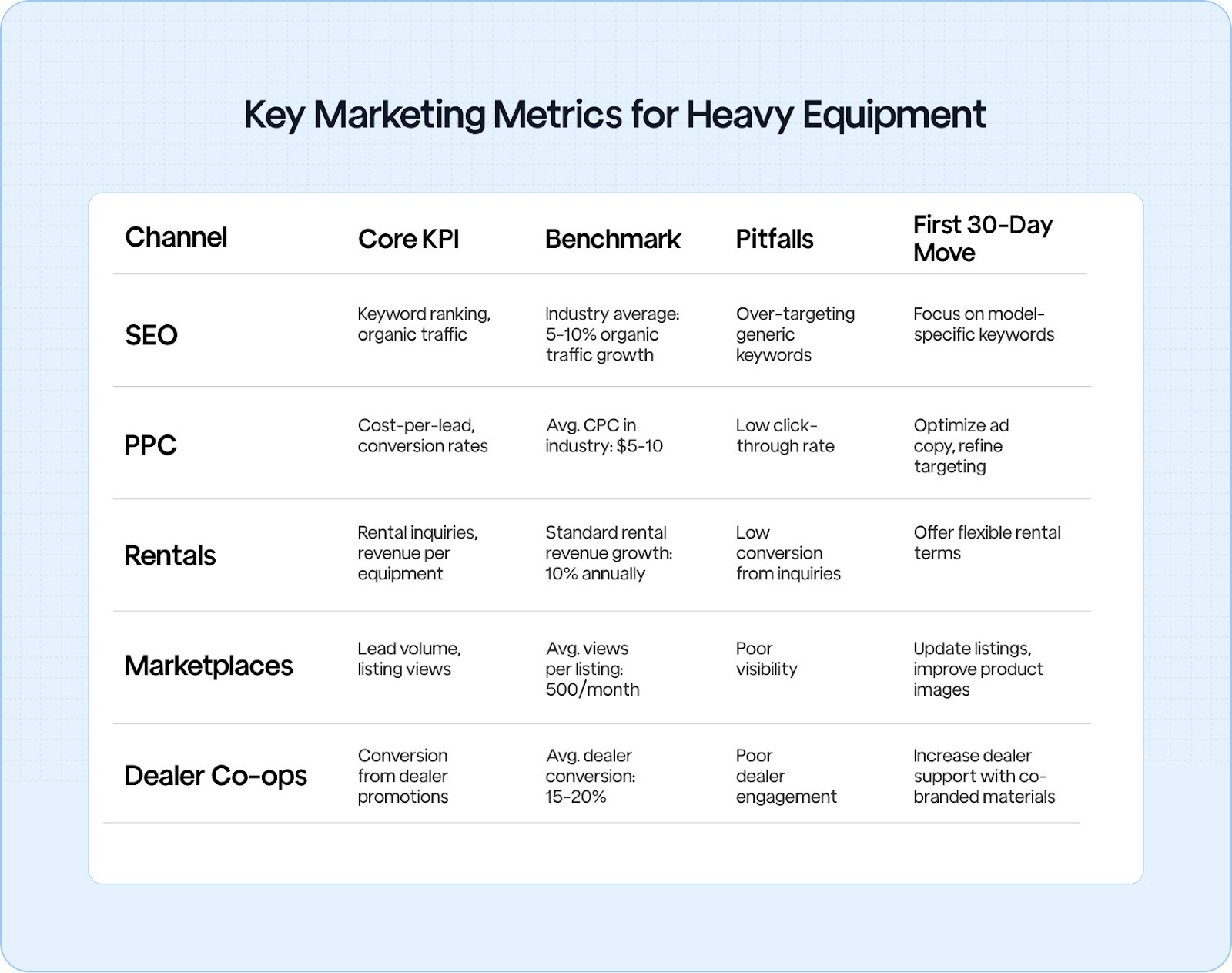
Understanding the key performance indicators (KPIs) for your heavy equipment marketing efforts helps you make data-driven decisions that drive real growth.
Quickly evaluate your current performance with a simple dashboard that covers:
To succeed today, you must balance three important factors: demand generation (creating interest), deal velocity (speed of closing sales), and lifetime value (LTV) (how much each customer is worth long term). These elements must work together for a smooth, efficient sales process.
Visual - Three gears labeled:
Your website is the cornerstone of your online presence, and a well-optimized site attracts more qualified leads and converts them into sales. A strong online foundation is essential to generating consistent traffic and providing value to potential customers.
Focus on:
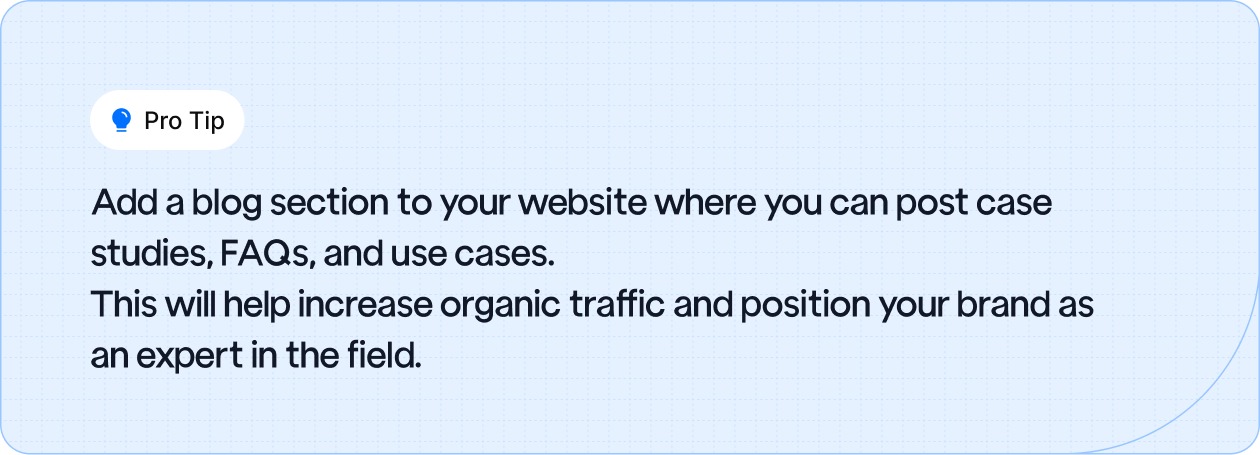
Marketplaces are a great way to gain visibility, but to really take advantage, you need to transform them from passive listings to active sales channels.
By leveraging data and best practices, you can turn these portals into consistent lead-generating machines.
How to:
Paid search allows you to target specific intent-driven buyers at the right time. By capturing high-intent keywords and offering tailored landing pages, you can increase conversions and improve ROI from your PPC efforts.
Cover:

Video marketing is essential for building trust by showcasing equipment in action.
Real-world jobsite footage and operator POV videos (views from the operator’s perspective) make your equipment seem more authentic.
Tips:
Dealer networks are a critical part of the sales funnel, but they often operate in silos. By centralizing resources and providing them with the right tools, you can speed up conversions and align efforts across all touchpoints.
Focus on:
Financial options are essential to converting prospects into buyers. By offering financing directly during the sales process, you can make it easier for customers to decide and speed up the decision-making process.
Add:
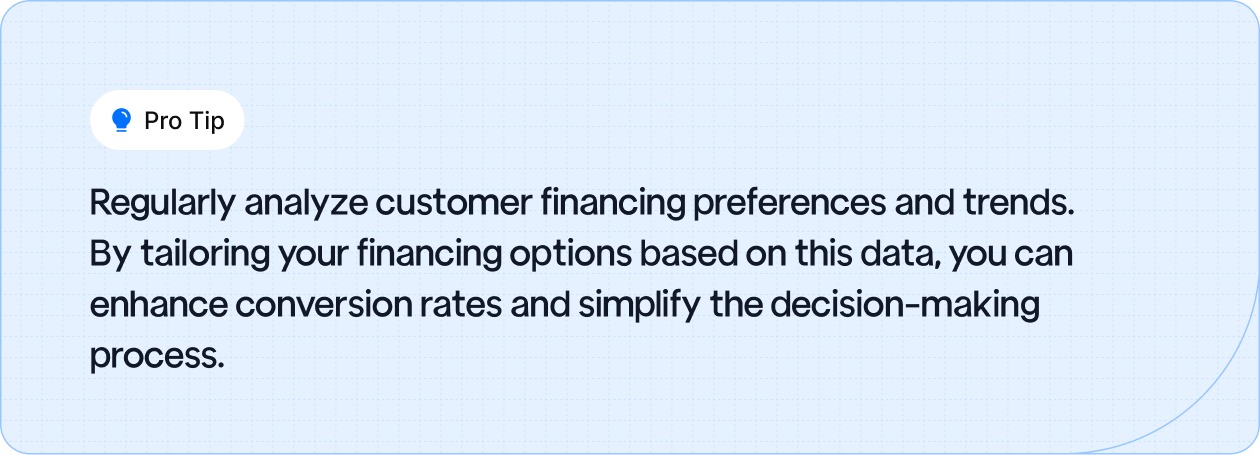
Telematics (data collected from equipment) provides real-time information on how your equipment is being used.
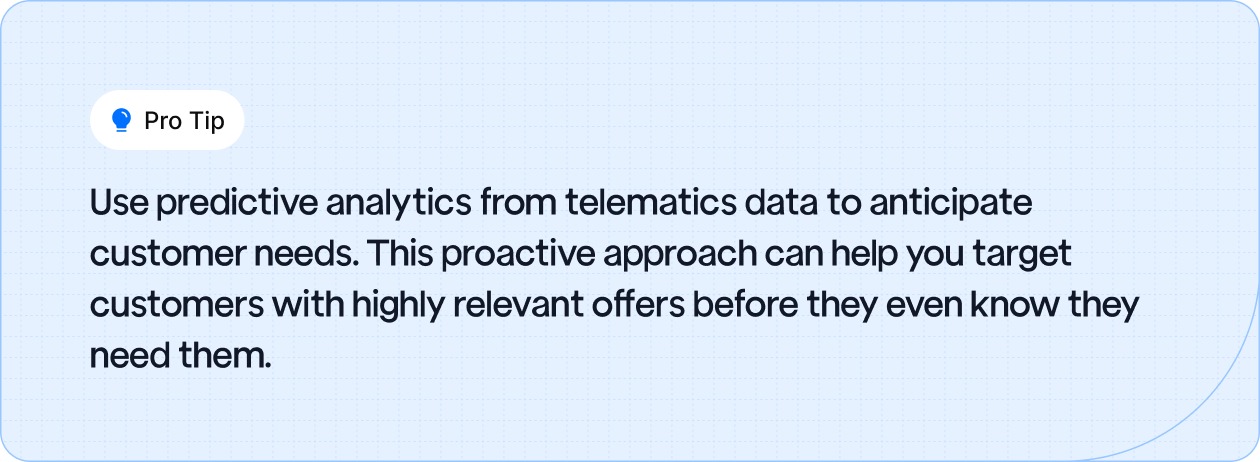
You can use this data to send timely and relevant marketing messages, improving outreach and increasing upsell opportunities.
Use:
On-site demos (showing the equipment in action) are powerful, but to fully benefit from them, you need to quickly capture leads and follow up effectively.
Add:
Service and parts are often overlooked but can be a major source of income. By tapping into this area, you can earn money long after the initial sale.
Show:
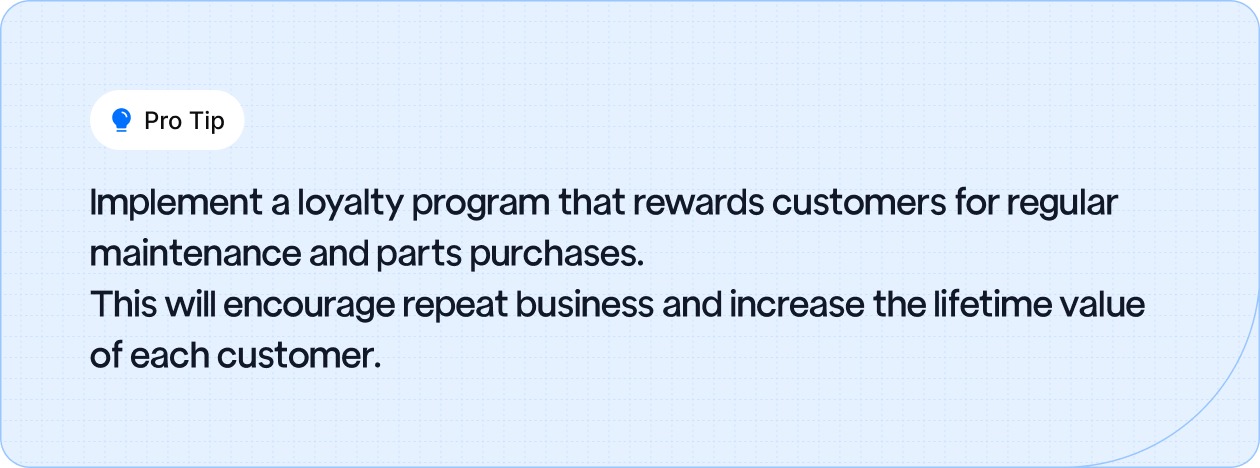
Educated operators help protect the longevity of equipment and increase brand loyalty. Providing training doesn’t just help your customers; it makes them loyal advocates for your brand.
Create:
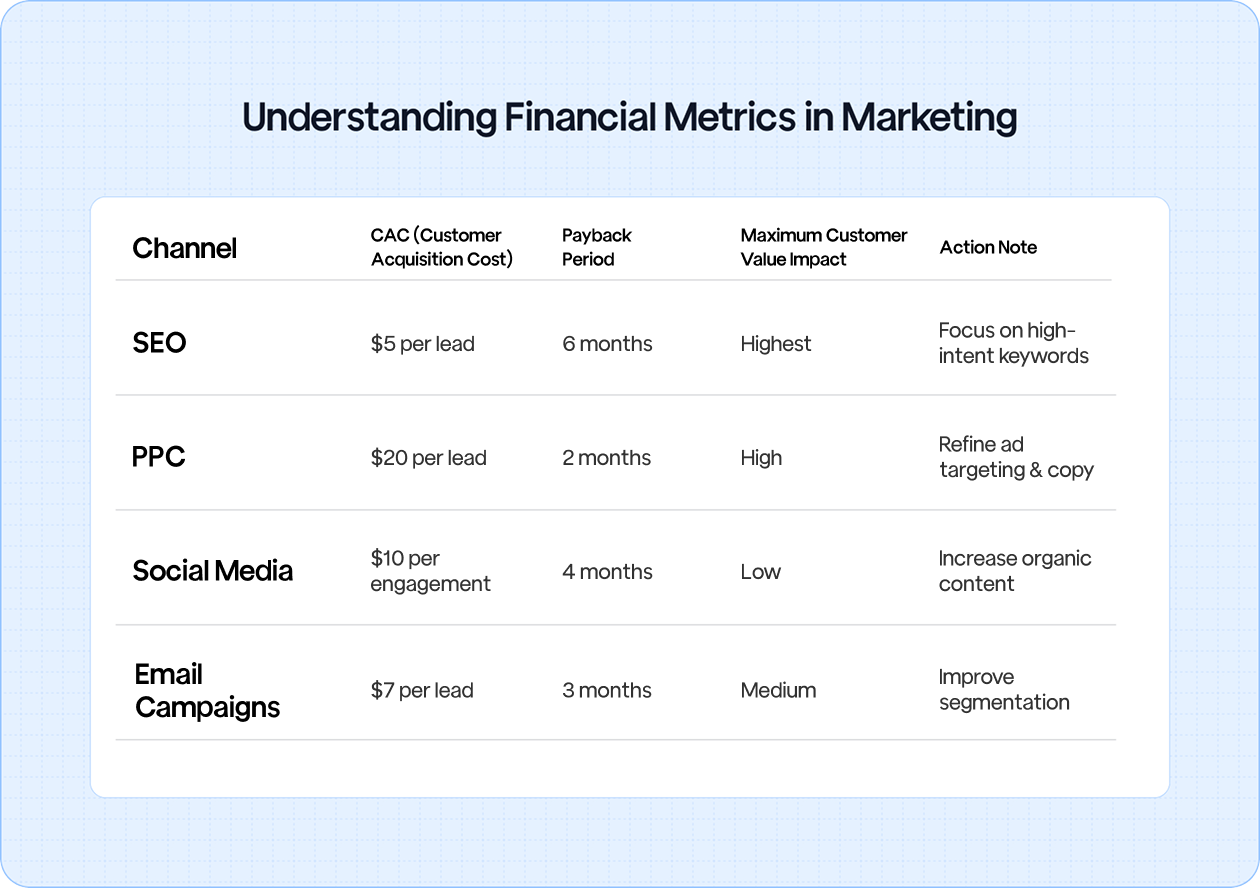
Knowing your financial metrics helps you prioritize the right marketing activities that generate the best ROI. Focusing on what truly drives revenue is critical for sustained growth.
Include:
Organizing your data correctly ensures faster decisions and efficient marketing. A centralized system means all your data is in one place, making it easier to keep campaigns consistent and accurate.
Stack:
Add governance notes:
Compliance shouldn’t hold back your marketing efforts. By integrating compliance checks into your workflows, you can move faster while avoiding potential legal and regulatory risks.
Highlight:
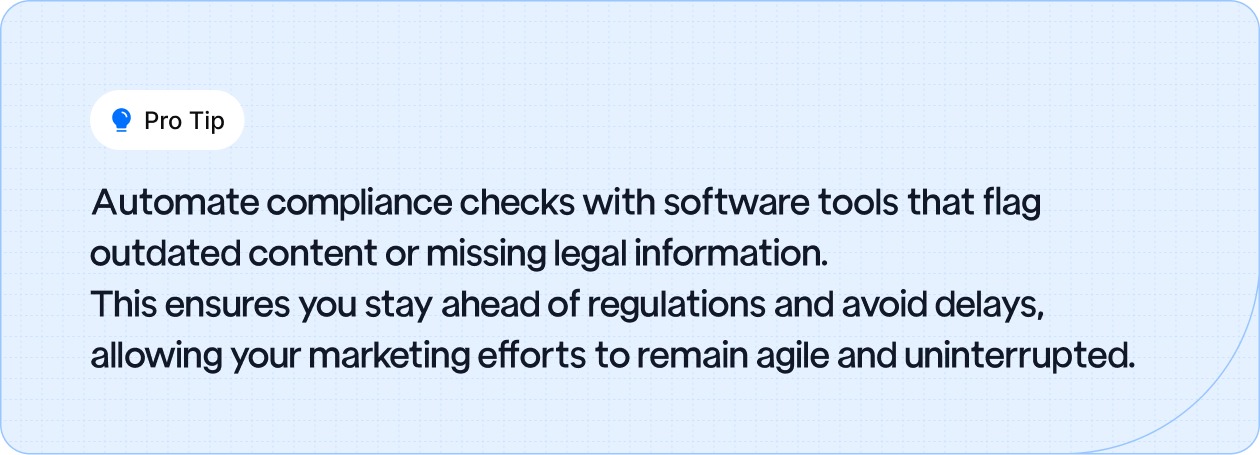
Speed matters. Instead of reinventing the wheel, use proven templates and frameworks that can be quickly customized to fit your needs and implemented immediately.
Offer:
Success stories and data-backed results help you feel confident in your strategy. Learn from proven tactics that have delivered significant returns for companies in your industry.
Examples:
You’ve seen what works: heavy equipment marketing is about smart strategies that drive sales, rentals, and service revenue.
The real challenge is the need for a comprehensive, tested approach to move the needle.
Ready to roll? Grab the plan or the KPI sheet.
Q1: What are the most important KPIs for heavy equipment marketing?
A1: The key performance indicators (KPIs) for heavy equipment marketing include SEO rankings, cost-per-lead (CPL) for paid ads, rental inquiries, and dealer co-op conversion rates. Tracking these metrics helps identify areas for improvement and ensures that marketing efforts are driving growth in sales, rentals, and service revenue.
Q2: How can I improve my heavy equipment website’s SEO?
A2: To improve your website's SEO, focus on optimizing model and category pages with high-intent keywords. Create “versus” content (e.g., “D6 vs 650M”) for better ranking, offer downloadable specs and CAD assets, and use structured data (schema) for FAQs to boost visibility and conversion rates.
Q3: What role do online marketplaces play in heavy equipment marketing?
A3: Marketplaces are essential for increasing visibility. By optimizing listings with complete, accurate data, using smart tags and badges, and linking back to your product pages, you can convert marketplace traffic into qualified leads and drive sales directly from these platforms.
Q4: How can telematics data be used to enhance heavy equipment marketing?
A4: Telematics data allows you to track equipment usage and automatically trigger marketing actions. For example, you can use fault codes to send service offers, schedule preventive maintenance, or promote equipment upgrades at the right time, improving customer engagement and increasing sales opportunities.
Q5: What’s the best way to generate high-quality leads for heavy equipment sales?
A5: Paid search strategies targeting high-intent keywords and geo-specific landing pages are effective for generating quality leads. Offering filters like “rent vs. buy” and embedding finance options directly into landing pages can simplify the decision-making process and increase conversions.
Q6: How can I use video marketing to sell heavy equipment?
A6: Video marketing is powerful for demonstrating equipment in action. Jobsite footage and operator POV videos can build trust and showcase product capabilities. Short videos on LinkedIn and YouTube can engage buyers and dealers, providing valuable content while driving traffic back to your website.
Q7: What’s the benefit of offering operator training in heavy equipment marketing?
A7: Operator training enhances brand loyalty and protects equipment longevity. Offering certification courses and on-demand maintenance tips builds trust with customers, turning them into advocates. These efforts also keep your brand top-of-mind, improving customer retention and creating lifelong relationships.





.svg)
.svg)
.svg)